- TemplateLab
- Project management

Contingency Plan Examples
40 detailed contingency plan examples (& free templates).
Good strategies always involve a contingency plan in case the original plan backfires. In some cases, the original plan may not be as successful as you expect which is why you need a contingency plan example to achieve the same goal . We have heard the term “Plan B” before and this in its simplest way, is a contingency plan.
Table of Contents
- 1 Contingency Plan Examples
- 2 What is a contingency plan?
- 3 Contingency Plan Templates
- 4 When to use a contingency plan?
- 5 Using a contingency plan example in risk project management
- 6 Business Contingency Plan Templates
- 7 Steps in contingency planning
- 8 Creating your contingency plan
- 9 Contingency Plan Samples
- 10 The challenges that may come with contingency planning
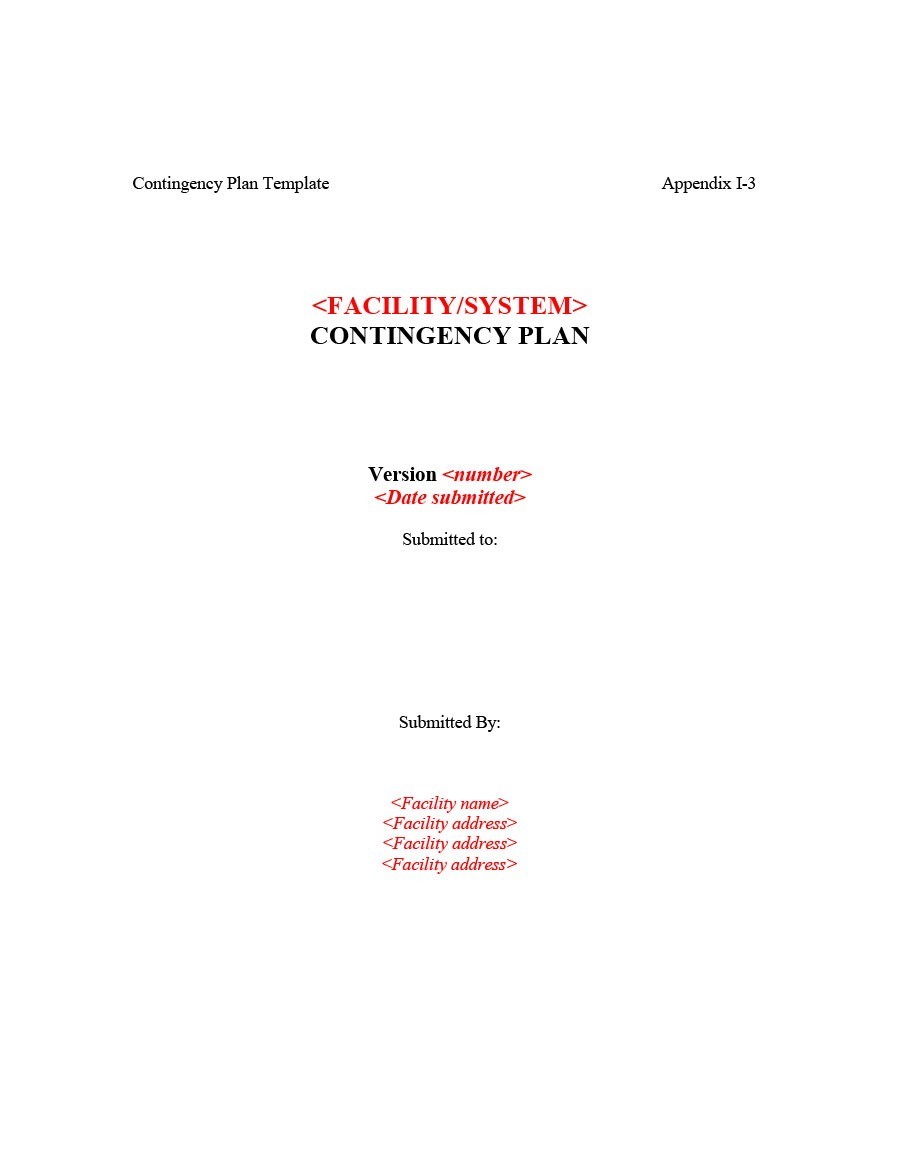
What is a contingency plan?
The steps taken by an organization when an unexpected situation or event occurs is a contingency plan. A contingency plan example may be positive like when there’s an unexpected surplus in the cash flow. But more often than not, the contingency planning process mostly refers to negative events.
The events which might have a bearing on the organization’s financial health, reputation or on its ability to continue with business operations. Such events may include natural disasters, fire, network failure, and a data breach, to name a few.
Having a contingency plan template helps you make sure that there’s always a continuity in the business. Most of the bigger business organizations have sets of business contingency plan templates for various potential threats. These undergo extensive research and the resulting appropriate responses get subjected to full practice even before the crisis occurs.
You can consider a contingency plan as a proactive approach as compared to crisis management, which is more of a reactive approach. Having a contingency plan ensures that you’re always prepared for any eventuality. Conversely, a plan for crisis management enables you to control the response after the eventuality occurs.
Contingency Plan Templates
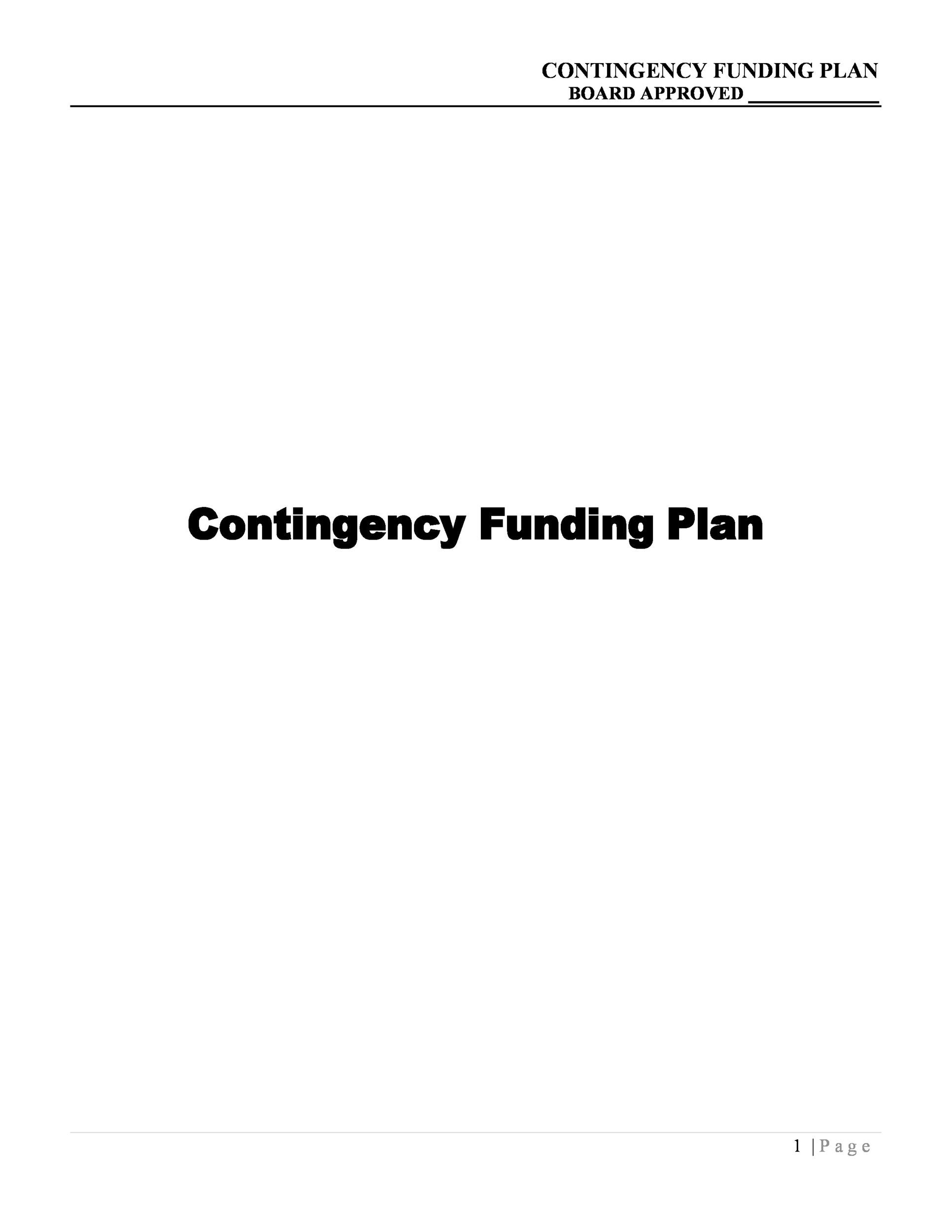
When to use a contingency plan?
Also, keep in mind that the design of a contingency plan template is only for risks that can you can identify and not for unknown or unidentified risks. This is for the simple reason that you cannot make a plan if you don’t know the risk.
It’s also worth noting that contingency plans don’t only exist in anticipation should things go wrong but you can also create one to make the most of strategic opportunities.
For instance, you have come to know of a new type of software for training that’s about to get released soon. Should this occur during the project, you can create a contingency plan on how to include this into the training stage of your project .
Using a contingency plan example in risk project management
As mentioned earlier, a contingency plan example responds to a negative event that might affect or tarnish the reputation of an organization or its financial standing. In business, however, a business contingency plan template isn’t always negative. There are cases of positive contingency plans too.
Also, keep in mind that the contingency planning process is a proactive strategy, unlike crisis management which is a reaction to something that has happened. A contingency plan accounts for any disruptive events to ensure that the company is always prepared if and when such events should occur.
Contingency plans are usually part of the risk management department and project managers should know that the plan is simply an outline. However, there are times when the project may extend beyond this. This means that the manager can be more prepared to make changes in the plan if he deems it would be more effective.
Risk management isn’t the same as the contingency planning process. Risk management is more about establishing, assessing, mitigating, avoiding, sharing, transferring, and accepting risks, whereas a contingency plan focuses on developing steps for when a risk occurs. But they share a common aspect. They both describe the steps to take in such an occurrence.
In its simplest form, a contingency plan definition is what you should do when an unexpected event takes place. Simpler still is “What if….?”, then creating an outline of the steps that answer this question.
Business Contingency Plan Templates
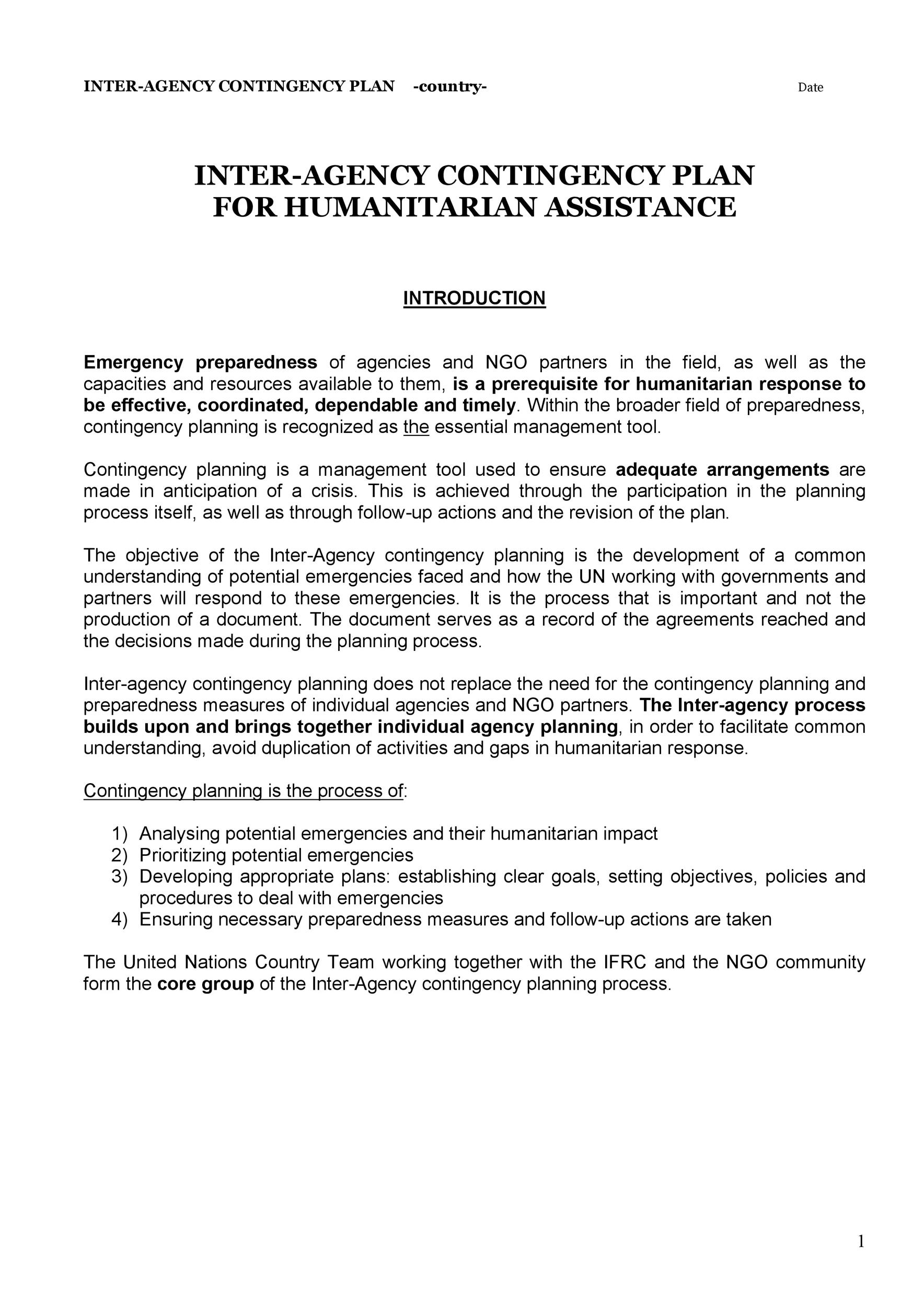
Steps in contingency planning
Project management always involves several entry points for risks that you have to consider for a contingency plan example. Here are some risk factors that you should take into account for a contingency plan template:
- The physical aspect where losses can happen caused by damage to facilities, equipment or information because of natural disasters or an accident.
- Technical issues may be a risk factor too, where the system stops functioning as needed for the delivery of the project as scheduled and within the budget.
- Human resources can be another risk too as teams may leave projects, get sick or get terminated.
- In a much larger scale, risk factors beyond the project manager’s control are social and political changes. As an example, you can work with a contract which can drastically change depending on who’s in control. Nothing remains stable with risk factors. Communities can even protest against projects and bring them to a halt.
- There are also liability issues where there are potential threats in the form of compensation plans and legal actions.
Here are the basic steps in the contingency planning process:
- Make it a point to know which resources can you use in the event of an emergency and in which part of the contingency plan you can apply these resources.
- Identify important dates that, if you miss, might negatively affect the plan. For instance, getting approval from committees which rarely meet.
- Know your plan. Check its weaknesses and strengths. Identify slack which you may find.
- Check for any points in the plan where you can apply alternative routes and evaluate each scenario to make your plan more flexible.
- Use your knowledge and experience in discerning patterns in the ebb and flow of the activities in your project to make it more efficient.
Creating your contingency plan
You need a lot of planning and research when creating a contingency plan example. But planning ahead, with each plan makes things easier for you. When creating one for your company, follow these steps:
- Identify your resources and prioritize them Do research throughout the organization so you can identify then prioritize the integral resources in your organization.
- Identify the most significant risks You need to identify any potential threats to the researched resources. If you need to, meet with executives, and employees to get more a holistic picture of how events can affect your resources. To be more precise, bring with you a consultant or a specialist in the identification of risks.
- Draft a contingency plan template Although you may come up with plans for each of the risks individually, it’s recommended to begin with the threats you consider high priority. This refers to the ones which have a high likelihood of occurring and would have the most significant impacts. As time goes by, you may start working toward coming up with plans for the lower-priority risks. When drafting plans for identified risks, start asking yourself about the steps to take so that the organization can go back to normal operations. Take into account factors like employee activity, communications, timelines , and staff responsibilities. Based on these, you can then make a plan for each of the risks.
- Share the plans Make sure that all employees and stakeholders have access to each plan as soon as you’ve completed them and had them approved. You may want to consider using a mobile application for this very important step. This could make the contingency plan together with similar documents directly available to all of the employees through their mobile service. This method also ensures that every employee has easy access to the updated plans for when the need arises.
- Maintain the plans As the organization undergoes changes, make sure that you reflect such changes in your business contingency plan template. There’s also a need to rehearse the plan with stakeholders regularly so that the key players know their roles and responsibilities.
Contingency Plan Samples
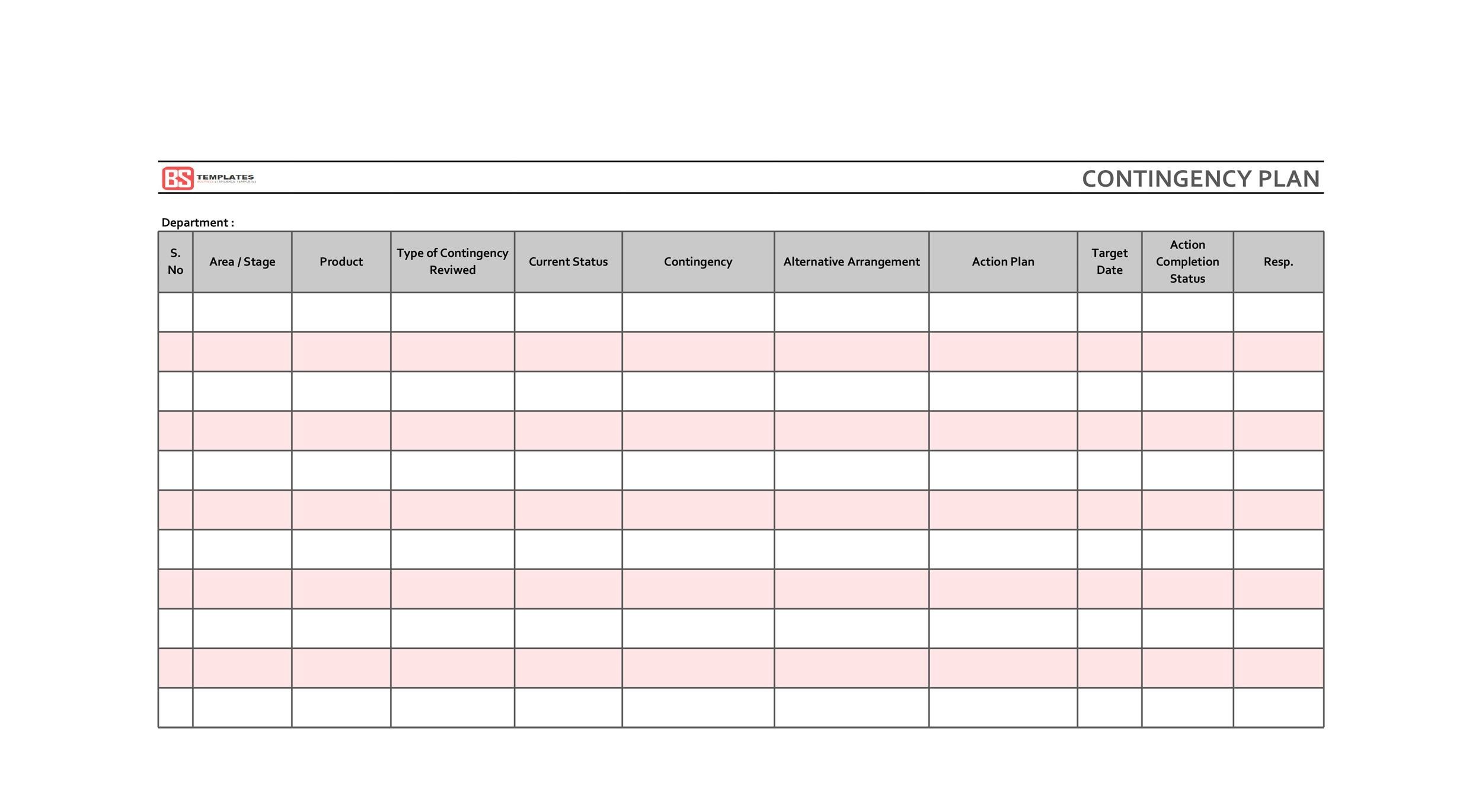
The challenges that may come with contingency planning
Managers will always get confronted with challenges that they should consider before and while creating contingency plans. These challenges include:
- Only focusing on “Plan A” By nature, people only want to work on a single solution. This may be the reason why a contingency plan doesn’t get the proper attention it deserves. They all hope “Plan A” succeeds and they think that focusing too much on “Plan B” might potentially be damage their success. As managers, they should stress how important a contingency plan is as it serves as your safeguard to help facilitate success instead of obstructing it. This means that the contingency plan should never get shelved. Instead, you must make it readily accessible.
- A small probability of using the plan Because of the small probability that you will ever use the contingency plan, many believe there’s no urgency in creating one. That means the plan could find itself at the very bottom of the company’s list of tasks if anyone will create it at all. There is a need for this plan for any project, even if the company has to invest a little more in it. When you decide to create a comprehensive contingency plan, you will feel the pay off when you end up needing it.
More Templates
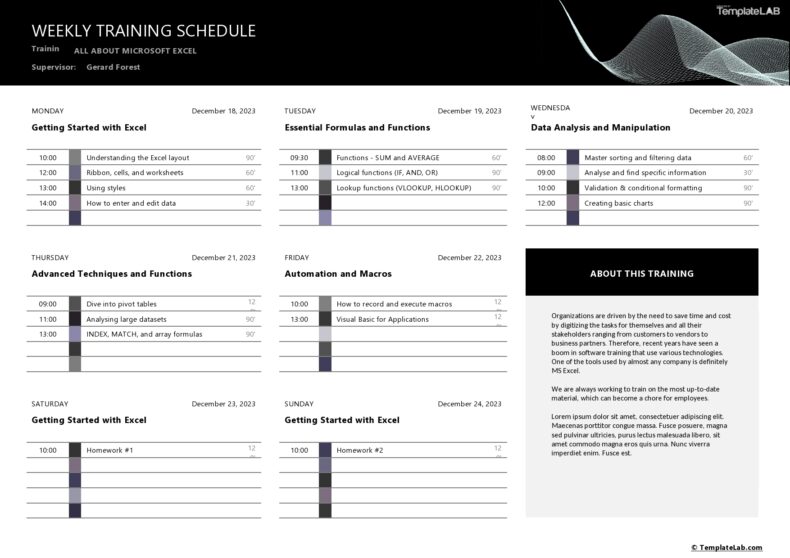
Training Plan Templates
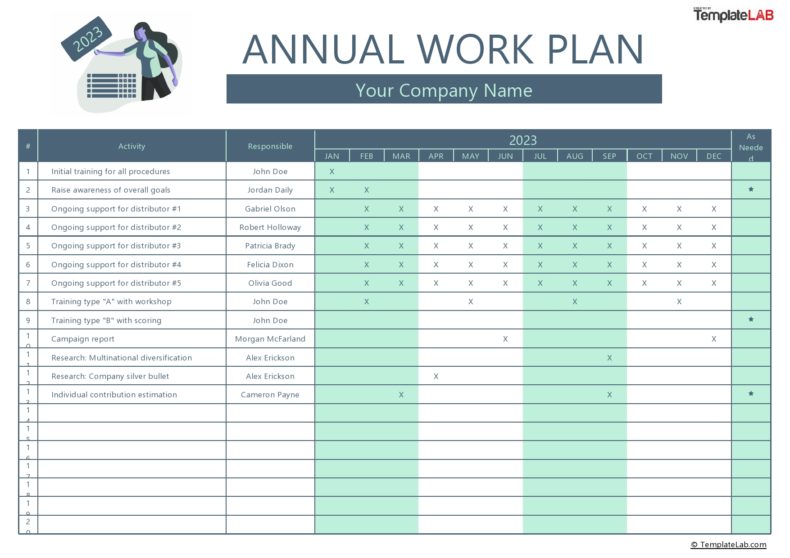
Work Plan Templates
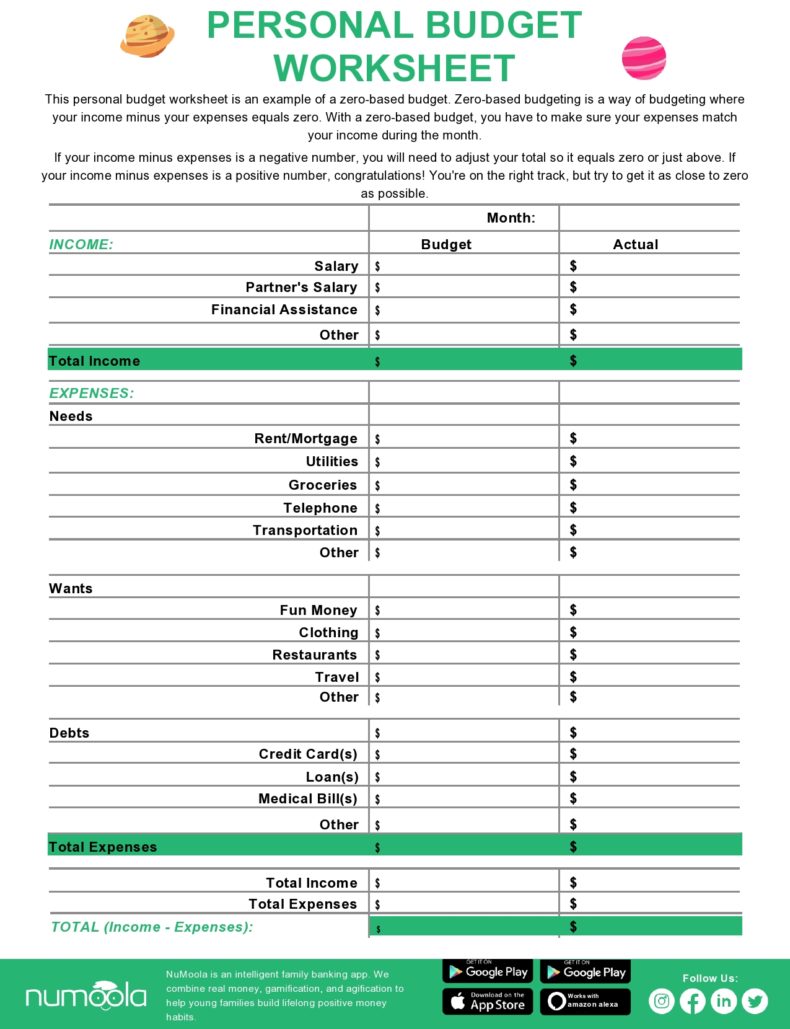
Zero Based Budget Templates
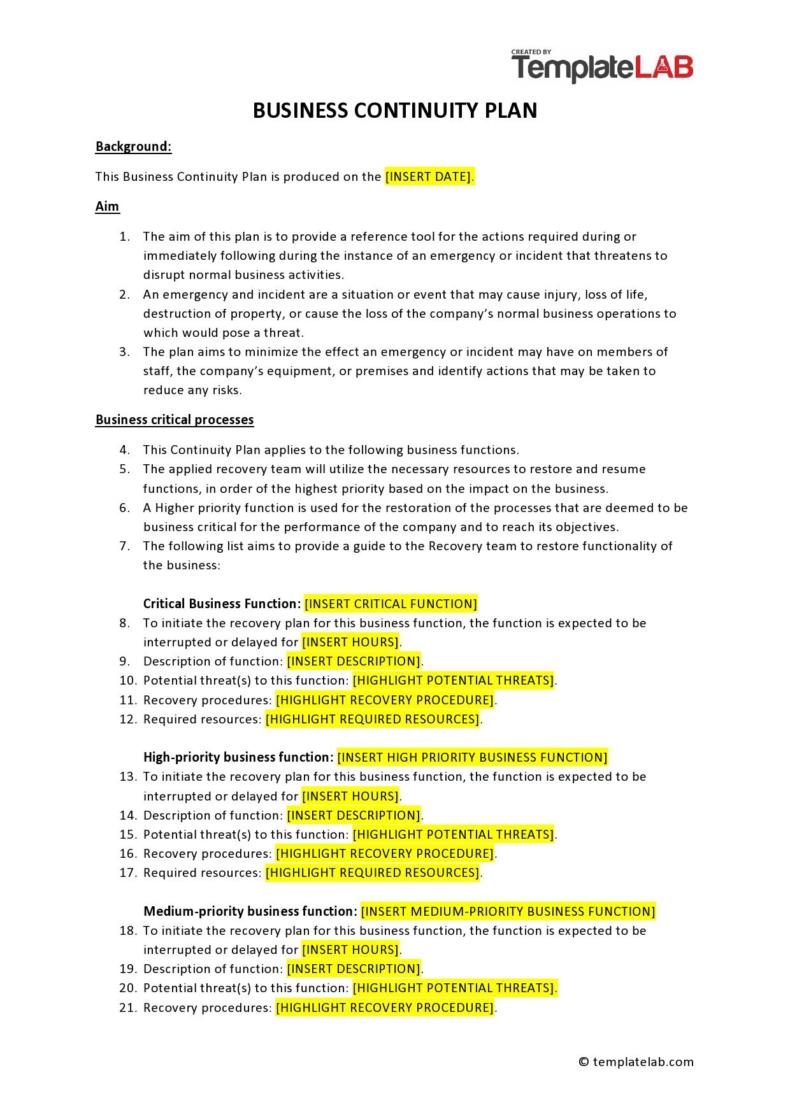
Business Continuity Plan Templates
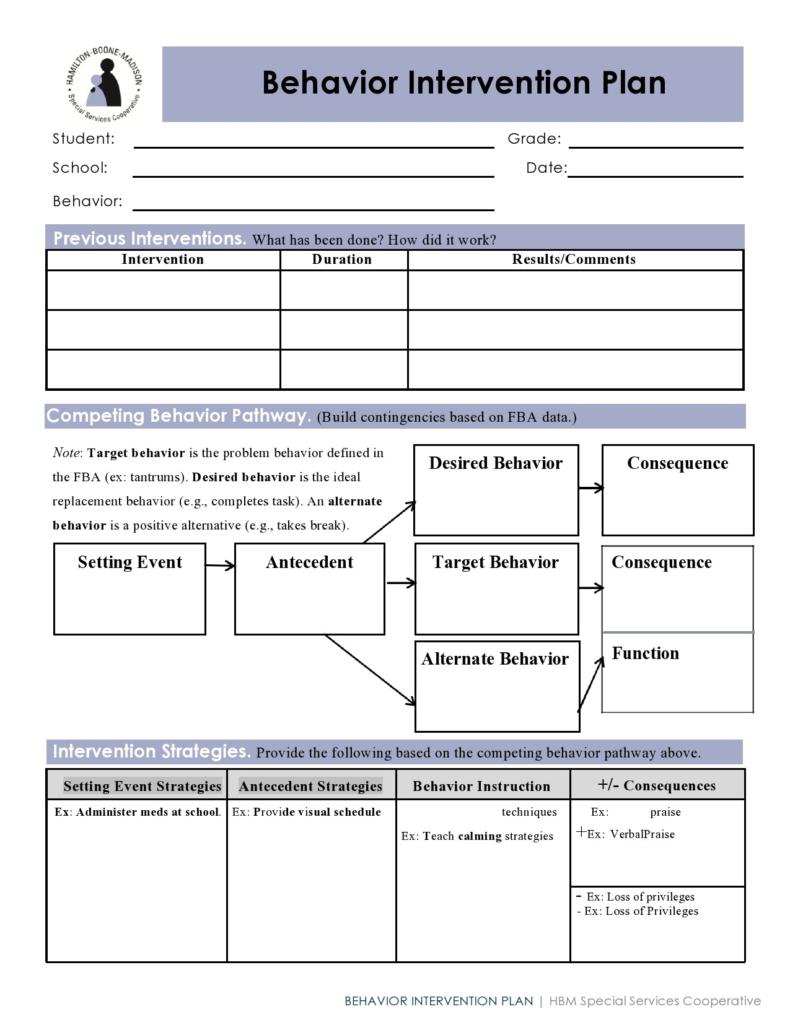
Behavior Plan Templates
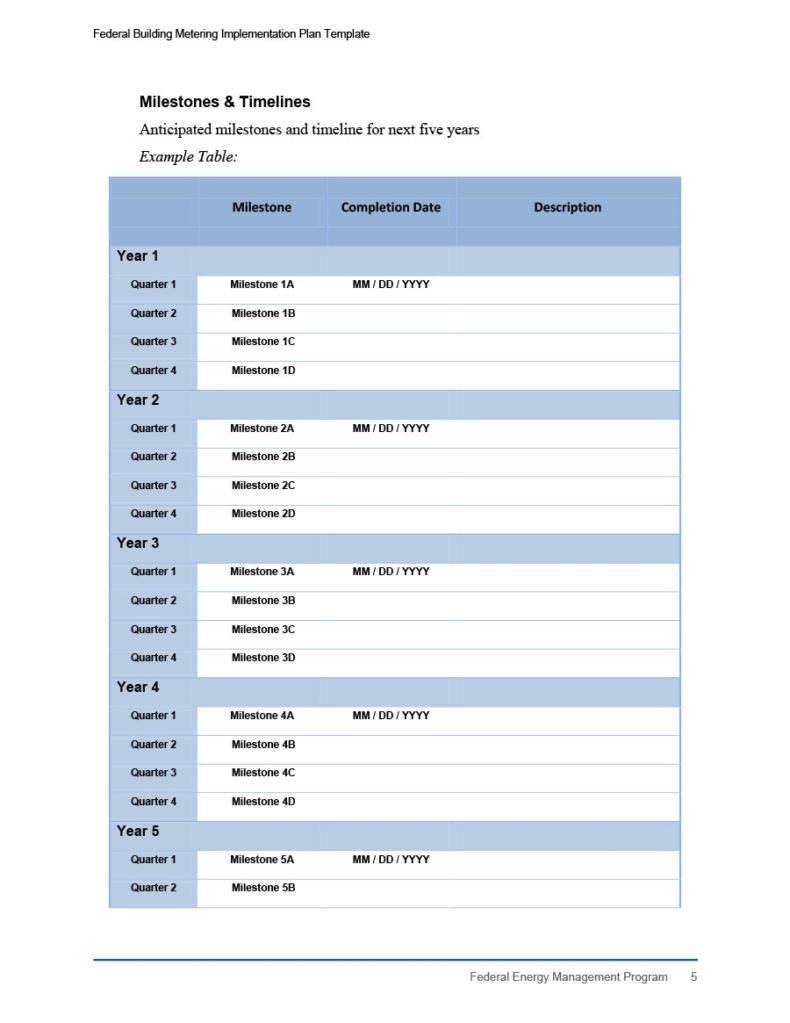
Implementation Plans
- Contact sales
Start free trial
What Is Contingency Planning? Creating a Contingency Plan

Table of Contents
What is contingency planning, what is a contingency plan, contingency plan example, how to create a contingency plan, business contingency plans, project contingency plans.
Contingency plans are used by smart managers who are aware that there are always risks that can sideline any project or business. Without having a contingency plan in place, your organization won’t be well prepared for risk management .
The term contingency planning refers to the process of preparing a plan to respond to any risks or unexpected events that might affect an organization. Contingency planning starts with a thorough risk assessment to identify any risks and then develop a contingency plan to resolve them or at least mitigate their negative impact.
Contingency planning takes many shapes as it’s used for helping businesses and projects across industries. Even governments use contingency plans to prepare for disaster recovery or economic disruption, such as those caused by natural disasters.
A contingency plan is an action plan that’s meant to help organizations mitigate the negative effects of risks. In simple terms, a contingency plan is an action plan that organizations should execute when things don’t go as expected.
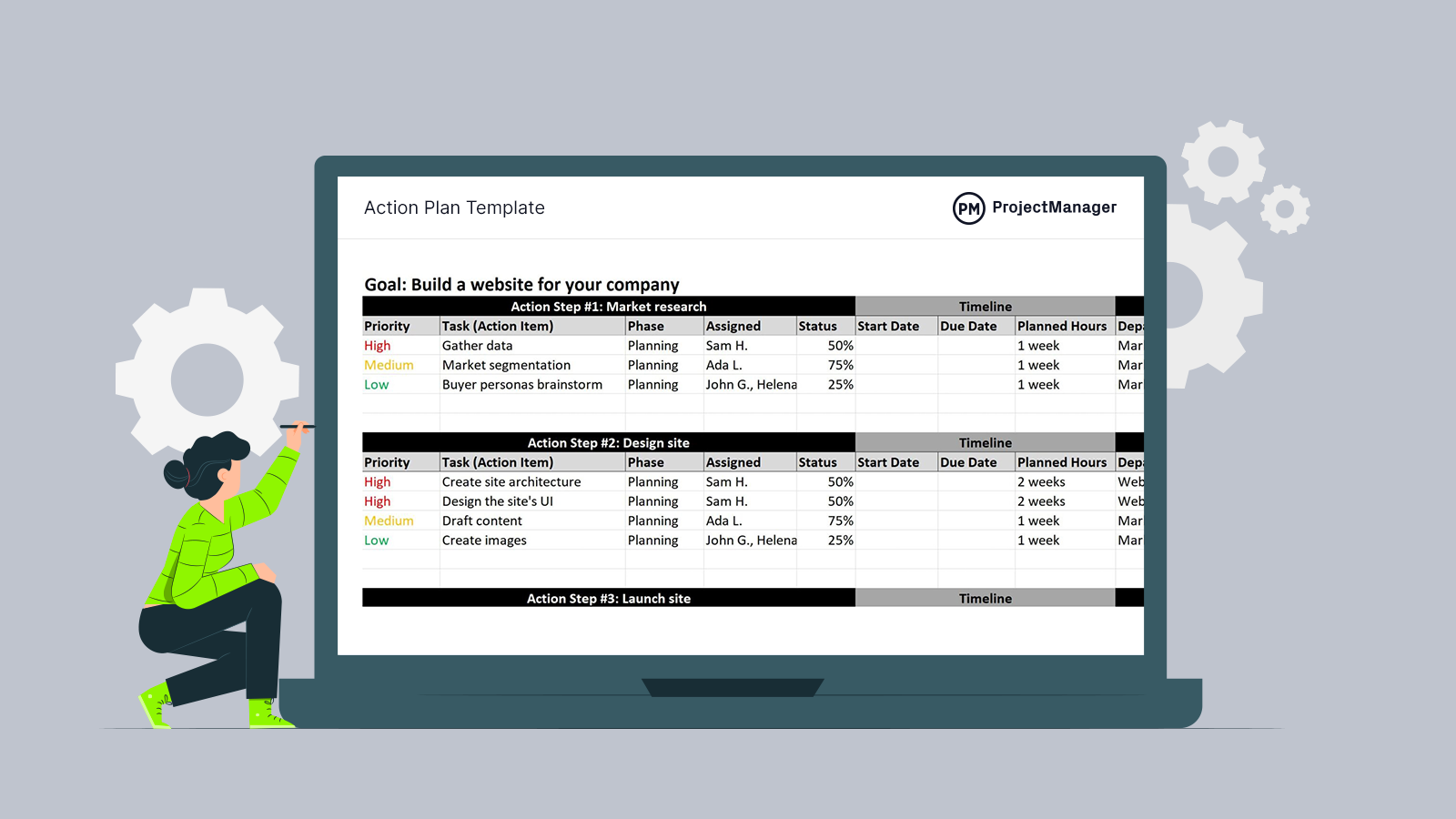
Get your free
Action Plan Template
Use this free Action Plan Template for Excel to manage your projects better.
Now that we’ve briefly defined what contingency planning is, let’s take a look at a contingency plan example involving a manufacturing project.
Let’s imagine a business that’s planning to manufacture a batch of products for an important client. Both parties have signed a contract that requires the manufacturer to deliver the products at a certain date or there may be negative consequences as stated on the purchase agreement. To avoid this, the business leaders of this manufacturing company start building a contingency plan.
To keep this project contingency plan example simple, let’s focus on three key risks this company should prepare for.
- Supply chain shortages: The supply chain is one of the most important business processes for this manufacturing company. Therefore, one of the most impactful risks is a raw material shortage which may occur if their main supplier is unable to deliver the materials they need on time. To prepare a contingency action for this risk, the business owners decide to reach out to other suppliers and place standing purchase orders which give them the opportunity to ask for a certain quantity of materials at some point in the future. If the risk of a supply chain shortage occurs, they’ll have multiple sources of raw materials available in case their main supplier can’t keep up with their demand levels.
- Machinery breakdown: Another risk that might halt production is the malfunction of machinery. To prepare for this, business leaders hire extra maintenance personnel and order spare parts for their production line machinery as part of their contingency plan. If the risk of machinery breakdown becomes a reality, the organization will have the labor and resources that are needed to mitigate it.
- The team is not meeting the schedule: If the manufacturing team members are failing to meet their goals on time for whatever reason, the manufacturing business will need to allocate more resources such as extra labor and equipment to complete the work faster. However, this contingency action will generate additional costs and reduce the profitability of the project.
ProjectManager has everything you need to build contingency plans to ensure your organization can respond effectively to risks. Use multiple planning tools such as Gantt charts, kanban boards and project calendars to assign work to your team and collaborate in real time. Plus, dashboards and reports let you track progress, costs and timelines. Get started today for free.

Like a project plan , a contingency plan requires a great deal of research and brainstorming. And like any good plan, there are steps to take to make sure you’re doing it right.
1. Identify Key Business Processes and Resources
To create an effective contingency plan you should first identify what are the key processes and resources that allow your organization to reach its business goals. This will help you understand what risks could be the most impactful to your organization. Research your company and list its crucial processes such as supply chain management or production planning as well as key resources, such as teams, tools, facilities, etc., then prioritize that list from most important to least important.
2. Identify the Risks
Now, identify all the risks that might affect your organization based on the processes and resources you’ve previously identified. Figure out where you’re vulnerable by brainstorming with employees, executives and stakeholders to get a full picture of what events could compromise your key business processes and resources; hire an outside consultant, if necessary. Once you’ve identified all the risks, you should use a risk log to track them later.
3. Analyze Risks Using a Risk Matrix
Once you’ve identified all the risks that might affect your processes and resources, you’ll need to establish the likelihood and level of impact for each of those risks by using a risk assessment matrix . This allows you to determine which risks should be prioritized.
4. Think About Risk Mitigation Strategies
Now, write a risk mitigation strategy for each risk that you identified in the above steps. Start with the risks that have a higher probability and higher impact, as those are the most critical to your business. As time permits you can create a plan for everything on your list.
5. Draft a Contingency Plan
Contingency plans should be simple and easy to understand for the different members of your audience, such as employees, executives and any other internal stakeholder. The main goal of a contingency plan is to ensure your team members know how to proceed if project risks occur so they can resume normal business operations.
6. Share the Plan
When you’ve written the contingency plan and it’s been approved, the next step is to ensure everyone in the organization has a copy. A contingency plan, no matter how thorough, isn’t effective if it hasn’t been properly communicated .
7. Revisit the Plan
A contingency plan isn’t chiseled in stone. It must be revisited, revised and maintained to reflect changes to the organization. As new employees, technologies and resources enter the picture, the contingency plan must be updated to handle them.
Contingency Plan Template
We’ve created an action plan template for Excel to help you as you go through the contingency planning process. With this template, you can list down tasks, resources, costs, due dates among other important details of your contingency plan.

A business contingency plan is an action plan that is used to respond to future events that might or might not affect a company in the future. In most cases, a contingency plan is devised to respond to a negative event that can tarnish a company’s reputation or even its business continuity. However, there are positive contingency plans, such as what to do if the organization receives an unexpected sum of money or other project resources .
The contingency plan is a proactive strategy, different from a risk response plan , which is more of a reaction to a risk event. A business contingency plan is set up to account for those disruptive events, so you’re prepared if and when they arrive.
While any organization is going to plan for its product or service to work successfully in the marketplace, that marketplace is anything but stable. That’s why every company needs a business contingency plan to be ready for both positive and negative risk management.
In project management, contingency planning is often part of risk management. Any project manager knows that a project plan is only an outline. Sometimes, unexpected changes and risks cause projects to extend beyond those lines. The more a manager can prepare for those risks, the more effective his project will be.
But risk management isn’t the same as contingency planning. Risk management is a project management knowledge area that consists of a set of tools and techniques that are used by project managers to create a risk management plan.
A risk management plan is a comprehensive document that covers everything about identifying, assessing, avoiding and mitigating risks.
On the other hand, a contingency plan is about developing risk management strategies to take when an actual issue occurs, similar to a risk response plan. Creating a contingency plan in project management can be as simple as asking, “What if…?” and then outlining the steps to your plan as you answer that question.
Using ProjectManager to Create a Contingency Plan
ProjectManager has the project planning and risk management tools you need to make a reliable contingency plan that can quickly be executed in a dire situation.
Use Task Lists to Outline the Elements
Use our task list feature to outline all the elements of a contingency plan. Since a contingency plan likely wouldn’t have any hard deadlines at first, this is a good way to list all the necessary tasks and resources. You can add comments and files to each task, so everyone will know what to do when the time comes.

Reference Dashboards to Monitor the Contingency Plan
Our dashboard gives you a bird’s eye view of all of the critical project metrics. It displays live data so you’re getting a real-time look at how your project is progressing. This live information can help you spot issues and resolve them to make sure that your contingency plan is a success. Which, given that it’s your plan B, is tantamount.

If you’re planning a project, include a contingency plan, and if you’re working on a contingency plan then have the right tools to get it done right. ProjectManager is online project management software that helps you create a shareable contingency plan, and then, if you need to, execute it, track its progress and make certain to resolve whatever problems it’s addressing. You can do this all in real time! What are you waiting for? Check out ProjectManager with this free 30-day trial today!

Deliver your projects on time and on budget
Start planning your projects.
Free Contingency Plan Templates
By Joe Weller | March 25, 2021 (updated April 24, 2023)
- Share on Facebook
- Share on LinkedIn
Link copied
Contingency plans offer organizations a proactive strategy for resuming daily functions and operations following unforeseen events. We’ve compiled the most useful contingency plan templates and tips on using them for various industries.
On this page, you'll find free contingency plan templates, including a simple contingency plan template , a software contingency plan template , a business contingency plan template , and a project management contingency plan template . Plus, learn how to use a contingency plan template .
Simple Contingency Plan Template
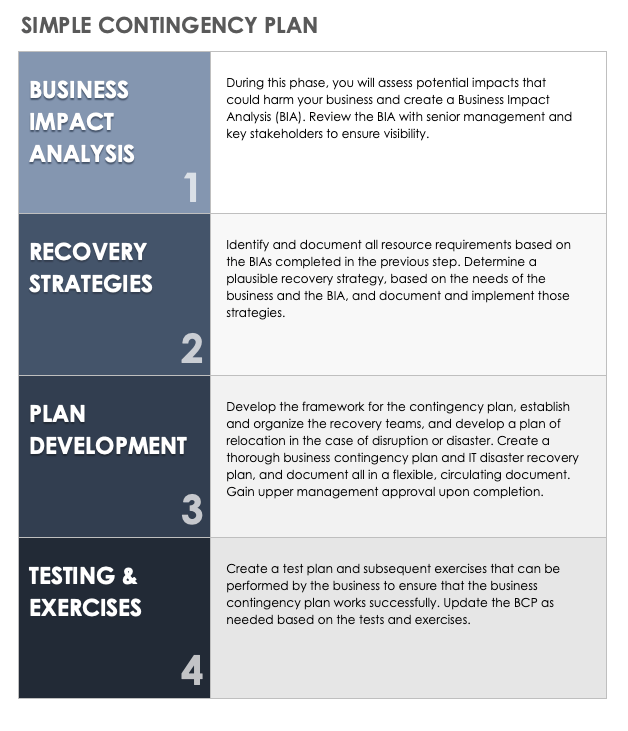
Use this simple contingency plan template to help your organization return to daily operations after unforeseen circumstances. Find sections for business impact analysis (BIA), recovery strategies, plan development, and testing and exercises. By completing these areas, you can stress-test your contingency plan. Assign contingency plan tasks to team members. Share the document with stakeholders to keep everyone apprised of the organization’s fail-safe contingency plan.
Download a Simple Contingency Plan Template for Microsoft Word | Adobe PDF | Smartsheet | Google Docs
For more resources on emergency response and contingency planning, see “ Free Risk Management Plan Templates .”
Simple Contingency Plan Presentation Template
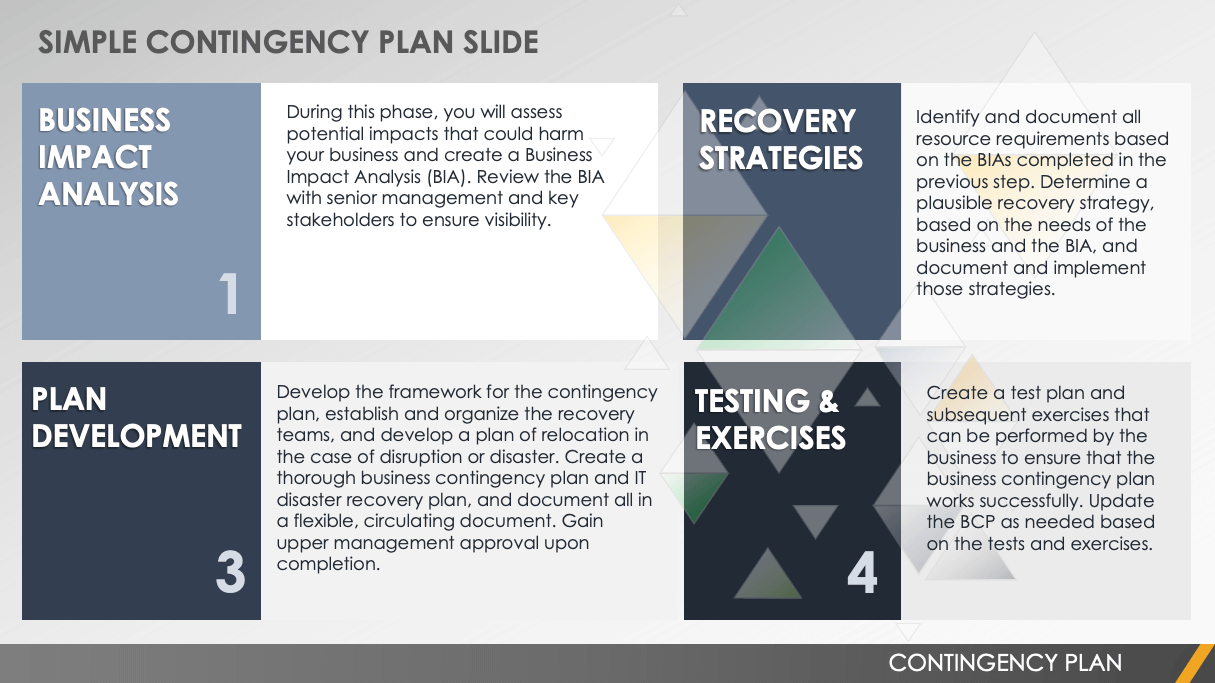
Use this simple contingency plan presentation template to highlight the details of your contingency plan to your team members and other stakeholders. Slides include details for business impact analysis (BIA), recovery strategies, contingency plan development, and plan testing and exercises. It also includes a comprehensive version history slide including your presentation plan’s version, approved by, revision date, descriptions of changes, author, prepared by, and approved by sections. Keep everyone in the loop with this easy-to-use contingency plan presentation template.
Download a Simple Contingency Plan Template for PowerPoint
To learn more, read this comprehensive guide on contingency planning.
Software Contingency Plan Template
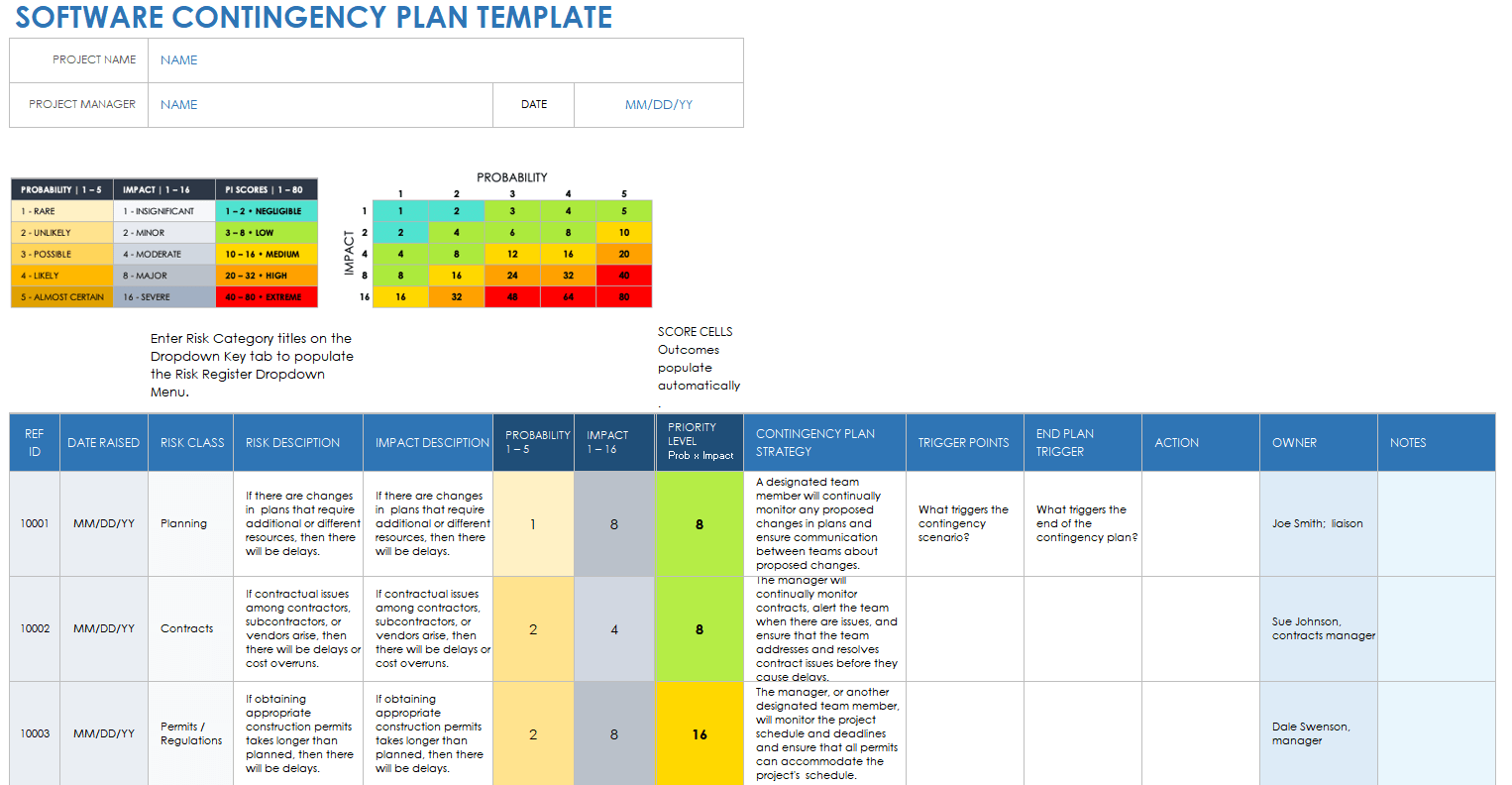
Use this software contingency plan template to identify, describe, and categorize risks, create an impact level and impact description, and create a contingency plan for each, in order to mitigate risks. For each risk, the template also includes a Trigger Points column (e.g., “What triggers the contingency scenario?”) and End Plan Trigger column (e.g., “What triggers the end of the contingency plan?”), so that team members understand the need for the contingency plan. Software project managers can use this template to create contingency plans related to data security, user privacy, geographically discrete data centers, or apply it to software development and software testing.
Download a Software Contingency Plan Template for Microsoft Excel | Google Sheets
Read this guide to contingency planning to find tips for improving your contingency preparedness.
Information Technology (IT) Service Contingency Plan Template
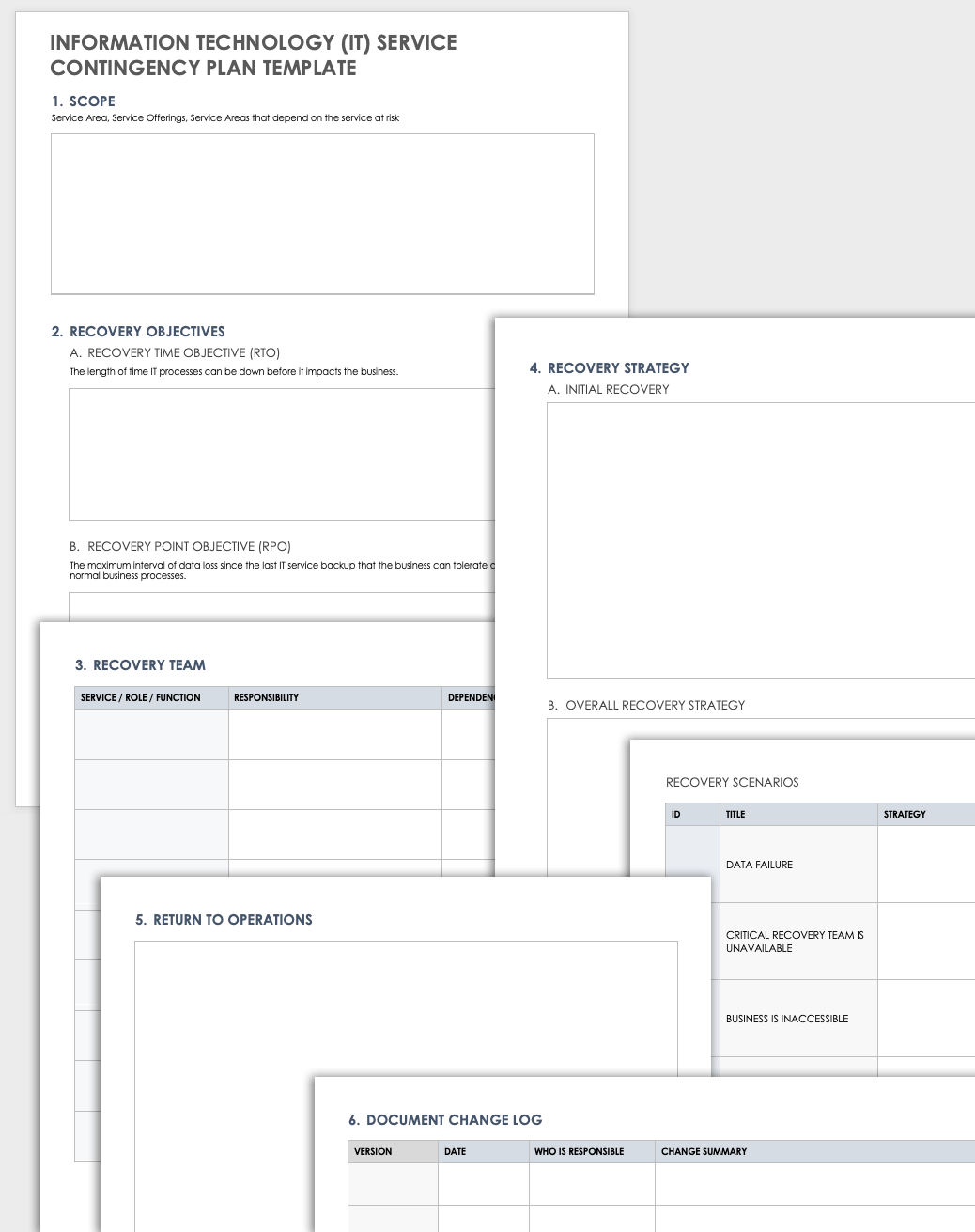
This easy-to-fill template focuses on keeping IT operations up and running in the event of a disruption. Use this template to document details of the scope, recovery objectives, recovery team, recovery strategy, and return-to-plan strategy of your IT department’s contingency plan. Be fully prepared for any incidents that cause downtime by using the proactive steps in this all-inclusive IT service continuity planning template.
Download an Information Technology (IT) Service Contingency Plan Template for Microsoft Word | Adobe PDF | Google Docs | Smartsheet
IT Service Contingency Plan Presentation Template
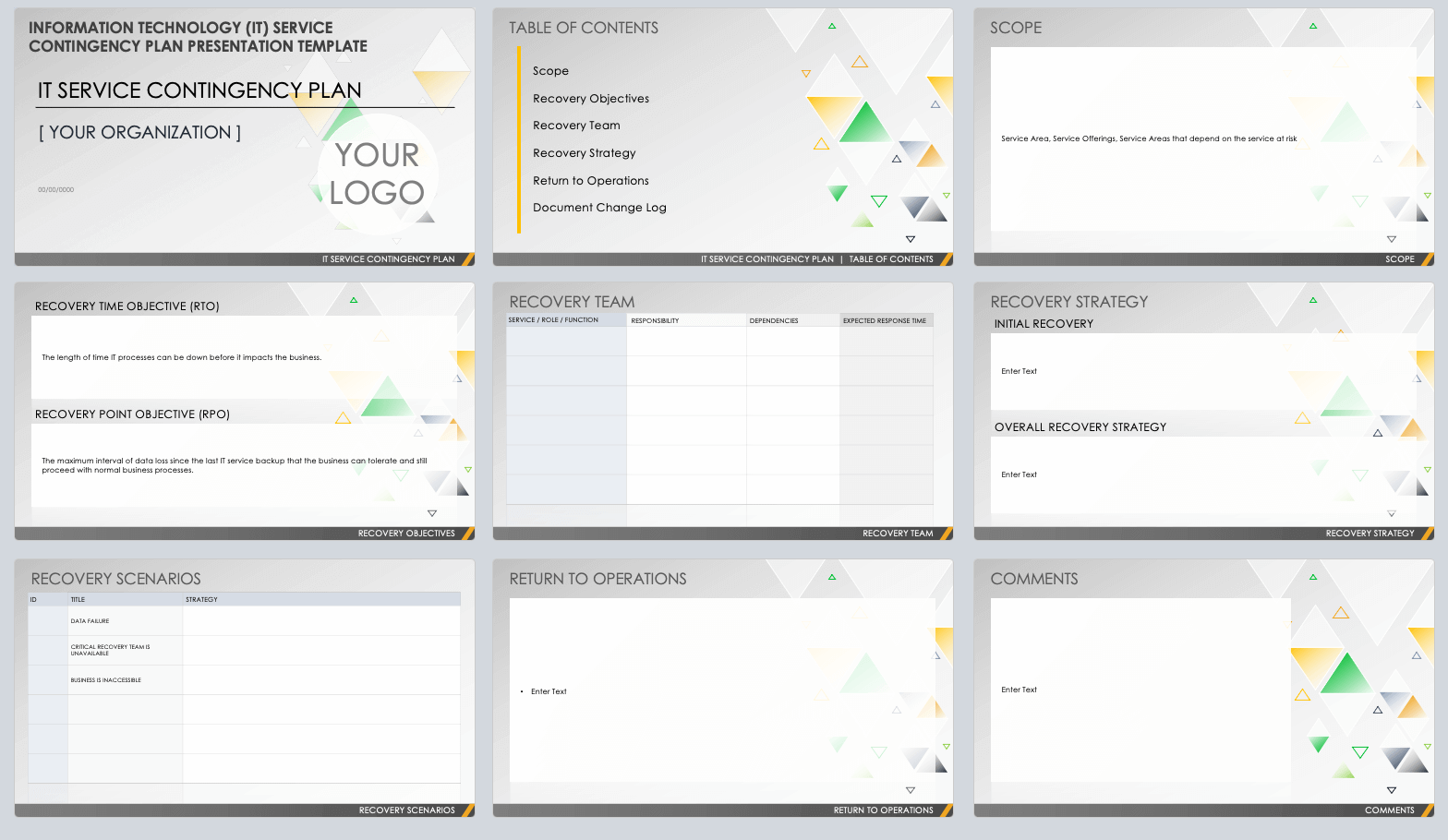
This easy-to-use information technology (IT) contingency plan presentation template is the perfect solution for presenting your IT contingency plan to key stakeholders. Slides include scope (service area, service offerings, and service areas that depend on the service at risk), recovery objectives (recovery time objectives, RTO; and recovery point objective, RPO), recovery team (service / role / function, responsibility, dependencies, and expected response time), and recovery strategy (initial recovery and overall recovery strategy). Easily gain buy-in from team members, management and other stakeholders with the all-in-one, IT-specific solution for outlining and refining your IT department’s service contingency plan.
Download an Information Technology (IT) Service Contingency Plan Template for PowerPoint | Google Slides | Smartsheet
Business Contingency Plan Template
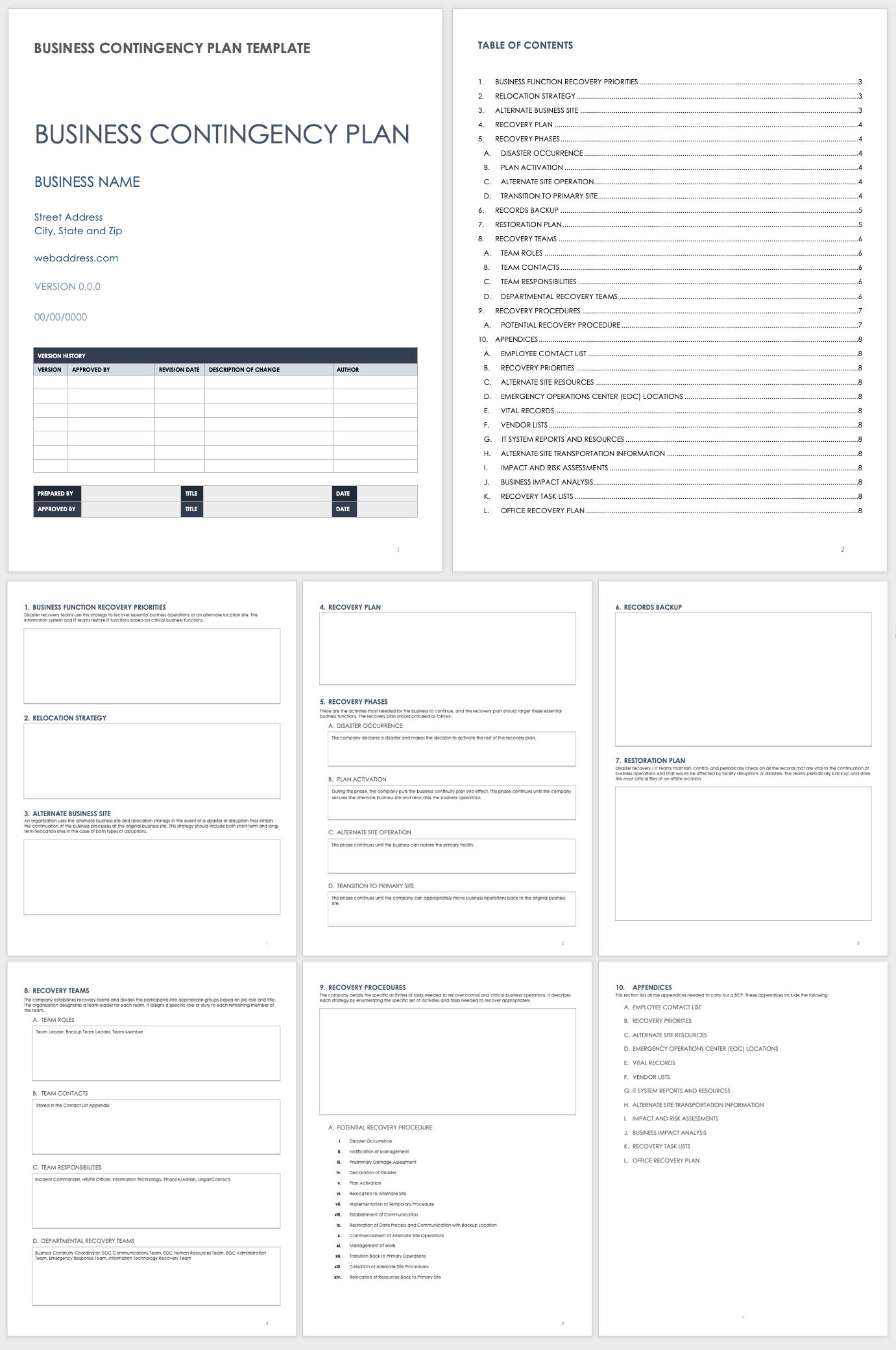
Keep tabs on your organization’s comprehensive business contingency plan (BCP) with this distinctive business contingency plan template. It guides you through your business function recovery priorities, relocation strategy, alternate business site, recovery plan, recovery phase, records and backup details, restoration plan, recovery teams, and recovery procedures. This BCP template is useful for determining accurate planning and courses of action to ensure the success of your business’s contingency plan.
Download a Business Contingency Plan Template for Microsoft Word | Google Docs | PowerPoint | Adobe PDF | Smartsheet
Business Contingency Framework Template

This one-page template features a broad-strokes framework for performing a business impact analysis (BIA), along with working out your recovery strategy, plan development, and testing and exercises. You’re never far from the big-picture vision of your business contingency plan with this efficient one-page business contingency framework template, available in Microsoft Word, PDF, Google Docs and Slides, and presentation-friendly PowerPoint formats.
Download a Business Contingency Framework Template for Microsoft Word | Adobe PDF | Google Docs | Google Slides | PowerPoint
For more resources on business contingency planning, see “ Free Business Continuity Plan Templates .”
Project Management Contingency Plan Template
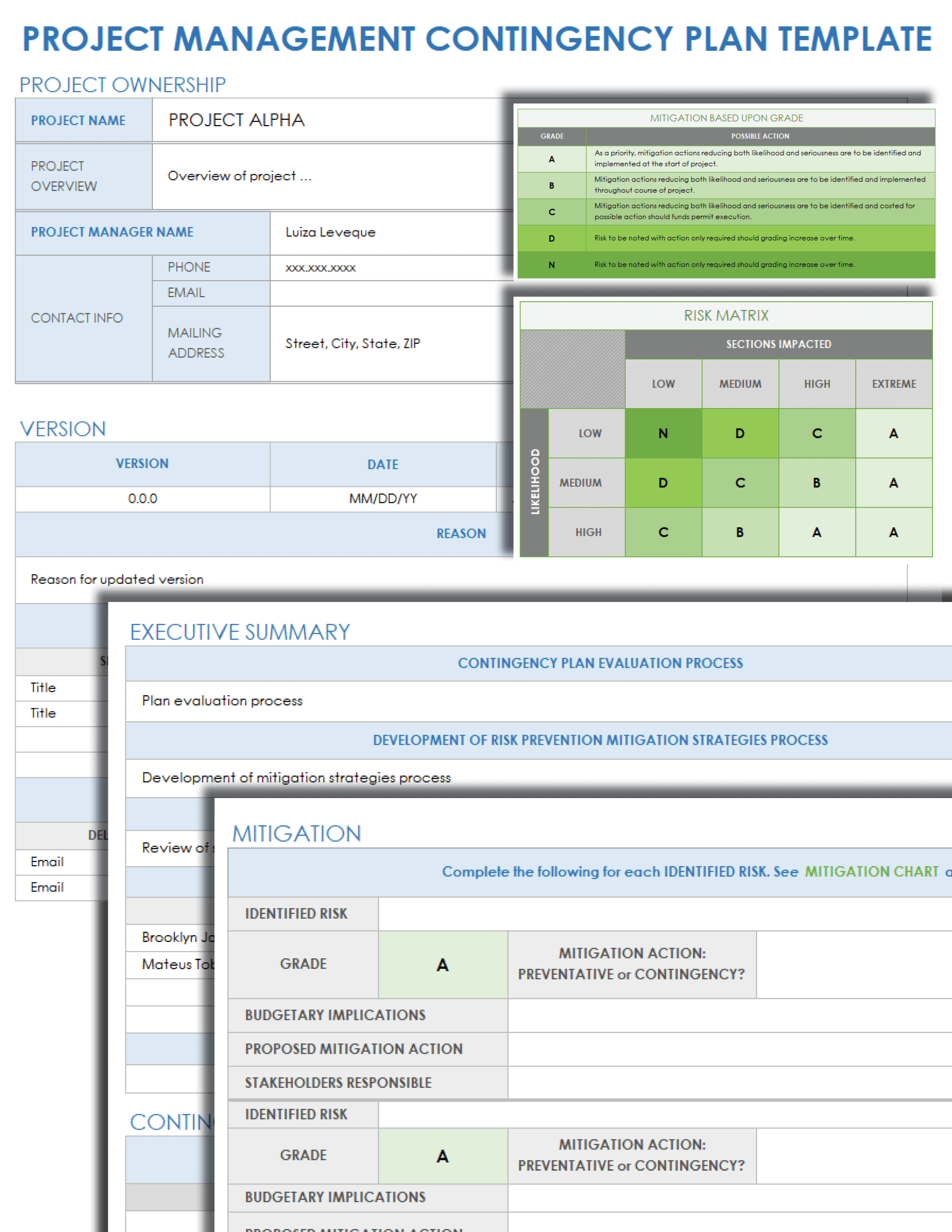
This project management contingency plan template is ideal for creating a comprehensive contingency plan for any type of project. The template enables you to create a high-level executive summary of your project’s contingency plan, including risk evaluation, a synopsis of your risk-prevention mitigation strategies process, and roles and responsibilities. Use this template to define risks and their events or triggers, consider budgetary implications, and define your potential plans of action.
Download a Project Management Contingency Plan Template for Excel | Google Sheets
Visit our article on contingency planning in project management for more information.
Small Business Contingency Plan Template
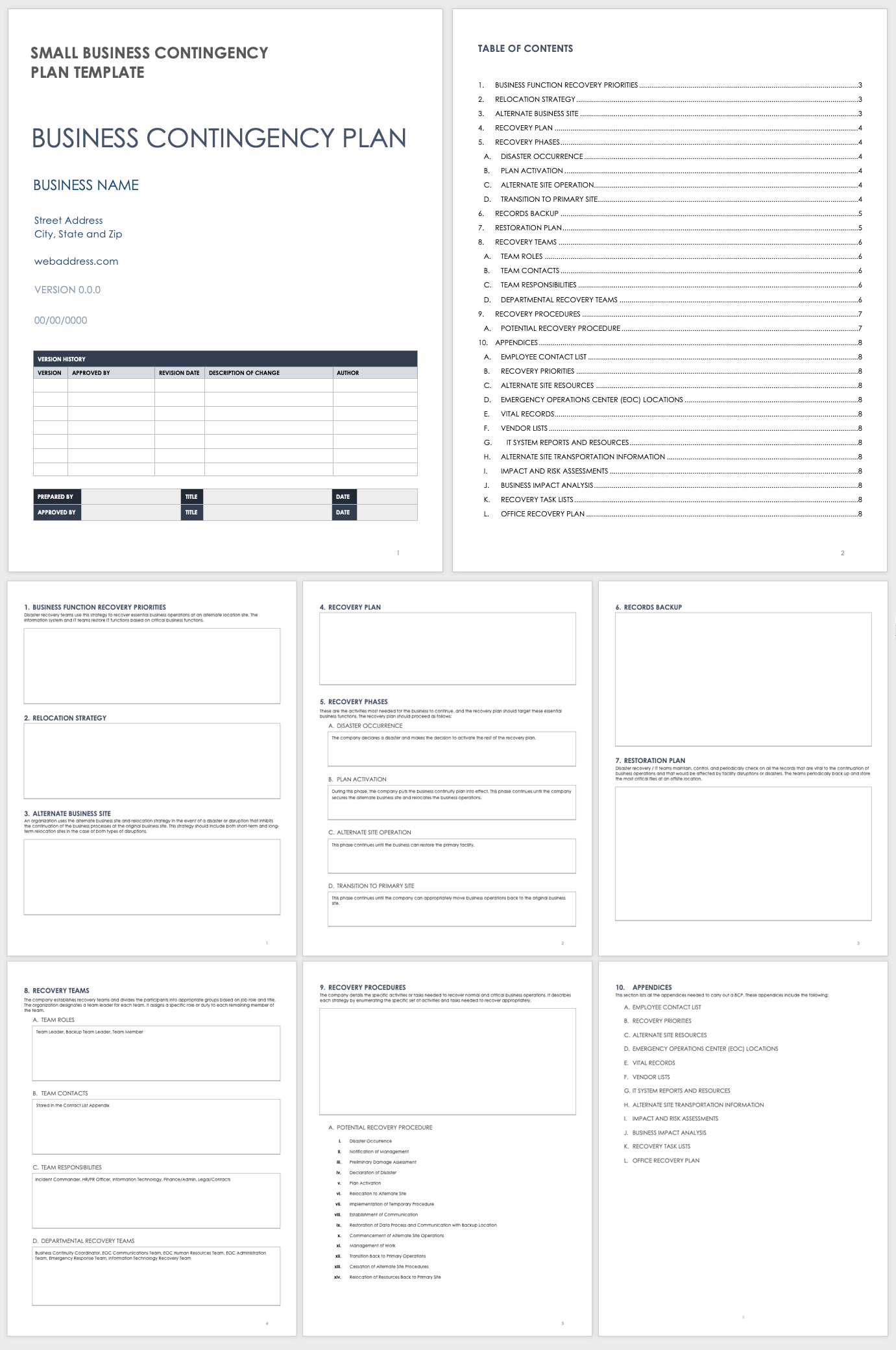
It’s critical for small businesses to have a comprehensive contingency plan that team members can reference in the event of a debilitating event or emergency. Designed specifically for small businesses, this template uses a pre-built, all-inclusive contingency plan to provide guidance for modestly sized organizations. Take the guesswork out of creating a contingency plan from scratch, and leverage the advantages of this small-business-specific template.
Download a Small Business Contingency Plan Template for Microsoft Word | Adobe PDF | Google Docs
For more resources on emergency response and contingency planning, check out our roundup of disaster recovery plan templates .
Contingency Plan Checklist Template
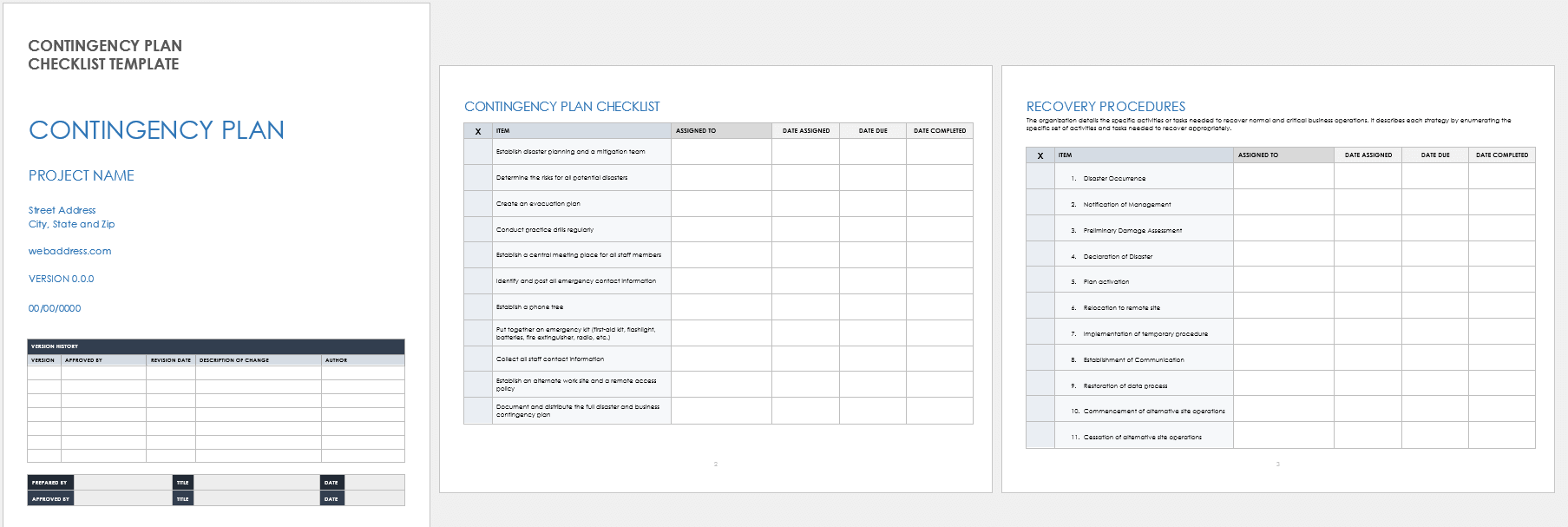
This two-part, fully customizable contingency plan checklist template contains a pre-built contingency plan checklist based on disaster-recovery steps, and a step-by-step, linear recovery procedure section. Use the latter section to ensure that everyone is aware of your contingency plan, if there is an event or occurrence that triggers the need to implement your plan. Then, use the checklist section to ensure that all steps in your contingency plan are in place, should you need to execute your contingency plan.
Download a Contingency Plan Checklist Template for Microsoft Word | Adobe PDF | Google Docs
What Is a Contingency Plan Template?
A contingency plan template provides a step-by-step process to communicate actionable items in the event of a disaster or disruption. The document takes the guesswork out of emergency planning, so you can protect resources, minimize interruptions, and identify go-to team contacts.
You can begin the contingency planning process by completing a contingency plan template so that you’re adequately prepared. By recording accurate and thorough information to ready yourself for an emergency, you can determine your priorities, relocation strategy, and recovery plan details. A contingency plan also helps you plan your organization’s recovery phases, work to ensure records backup, create a restoration plan, establish a recovery team, and assign roles to key individuals.
When to Use a Contingency Plan
You should use a contingency plan if there is the risk of an unexpected event that could impact your project’s success. A contingency plan is a backup plan that outlines steps for you to take in case the original plan encounters unforeseen obstacles.
The following provides a list of typical scenarios where you should use a contingency plan:
- Risky or Uncertain Situations: When there are potential risks or uncertainties that could impact the success of your project, it's a good idea to have a contingency plan in place to mitigate those risks.
- Time-Sensitive Projects: When you have a tight deadline or critical timeline that you must meet, a contingency plan can help ensure that your project is completed on time, even if unexpected issues arise.
- Resource Limitations: When you have resource constraints, such as budget or personnel, a contingency plan can help you effectively allocate resources.
- Emergency Situations: When emergencies (e.g., natural disasters, pandemics, or other crises) can impact your ability to complete your project, a contingency plan can help you and your organization respond quickly and efficiently.
Overall, you should use a contingency plan whenever there is a potential risk or uncertainty that could impact the success of your project or goal, or when there is the possibility of emergencies. When unexpected events occur, it's always better to be proactively prepared by having a plan in place, instead of scrambling to come up with a solution.
Sections of a Contingency Plan Template:
While your contingency plan will vary to meet the needs of your project, below are the common elements of a contingency plan:
- Recovery Priorities: Enter contingency plan priorities, including recovering essential operations and restoring critical functions.
- Relocation Strategy: Add the relocation strategy when your contingency plan requires moving your primary services.
- Alternate Site: Document alternate site details when you determine the secondary site where you can continue operations.
- Recovery Plan: Enter the step-by-step recovery-plan details to get your organization operational again.
- Disaster Occurrence: Use this phase to identify what constitutes a disaster that requires your organization to activate the contingency plan.
- Plan Activation: In this phase, your organization puts your contingency plan into effect, which continues until your organization secures an alternate site and can relocate operations.
- Alternate Site Operation: Operations continue at the secondary facility until you can restore them at the original site.
- Transition to Primary Site: The organization prepares to move operations back to the original site.
- Records Backup: Enter contingency plan details about how you’ll back up records and make them accessible in the event of a disaster or disruption.
- Restoration Plan: Add your plan for ensuring that all operations, records, etc., are able to be operational in the event of a facility disruption or disaster.
- Recovery Teams: List the recovery team(s) and members. Assign contingency plan tasks based on job role and title.
- Recovery Procedures: Enter details of specific activities or tasks required to adequately recover normal and critical operations.
Additionally, a contingency plan template enables you to track changes to your plan through a section for version history, comprising the following data:
- Version: Enter the unique version number for the most up-to-date iteration of the plan.
- Approved By: Ensure that department heads or other stakeholders have approved the contingency plan.
- Revision Date: Provide the date when a substantial revision was made to your contingency plan.
- Description of Change: List details of the change(s) made to the plan.
- Author: Record the name of the plan’s primary author.
How to Create a Contingency Plan
When creating a contingency plan, be proactive, thorough, and adaptable. By anticipating potential risks and developing a well-documented plan of action, organizations can minimize the negative impact of unexpected events and ensure continuity of critical functions and key services.
Here are some key steps to follow when creating a contingency plan:
- Identify Potential Risks: First, identify potential risks or unexpected events that could impact the success of your project. Brainstorm with stakeholders and team members to identify as many potential risks as possible.
- Assess the Impact: Once you have identified potential risks, assess each risk’s potential impact. This will help you prioritize risks and determine which ones require immediate attention.
- Develop Response Strategies: Based on your impact assessment, develop response strategies for each potential risk. This may involve developing alternative solutions or workarounds, identifying additional resources, or establishing clear communication protocols.
- Assign Responsibilities: Determine who will be responsible for executing the contingency plan if and when it is necessary. Assign specific roles and responsibilities to stakeholders or team members to ensure that everyone knows what they’ll need to do.
- Establish Communication Protocols: Establish clear communication protocols so that team members and stakeholders know how to report potential risks or unexpected events and receive updates on the status of the contingency plan.
- Test and Refine Your Plan: Test the contingency plan periodically to ensure that it works effectively. Make adjustments as needed.
- Document Your Plan: Document the contingency plan in a clear and concise manner and make it easily accessible to all relevant parties.
Keep in mind that a contingency plan is only effective if you regularly review and update it to reflect changing circumstances and new risks that may arise.
Drive Results With Effective Contingency Planning in Smartsheet
From simple task management and project planning to complex resource and portfolio management, Smartsheet helps you improve collaboration and increase work velocity -- empowering you to get more done.
The Smartsheet platform makes it easy to plan, capture, manage, and report on work from anywhere, helping your team be more effective and get more done. Report on key metrics and get real-time visibility into work as it happens with roll-up reports, dashboards, and automated workflows built to keep your team connected and informed.
When teams have clarity into the work getting done, there’s no telling how much more they can accomplish in the same amount of time. Try Smartsheet for free, today.
Discover a better way to streamline workflows and eliminate silos for good.
Enterprises are often defined by how they deal with events that are out of their control. For example, how you react to a disruptive technology or cope with a sudden change in the markets can be the difference between success and failure.
Contingency planning is the art of preparing for the unexpected. But where do you start and how do you separate the threats that could do real harm to your business from the ones that aren’t as critical?
Here are some important definitions, best practices and strong examples to help you build contingency plans for whatever your business faces.
What is a contingency plan?
Business contingency plans, also known as “business continuity plans” or “emergency response plans” are action plans to help organizations resume normal business operations after an unintended interruption. Organizations build contingency plans to help them face a variety of threats, including natural disasters, unplanned downtime, data loss, network breaches and sudden shifts in customer demand.
A good place to start is with a series of “what if” questions that propose various worst-case scenarios you’ll need to have a plan for. For example:
- What if a critical asset breaks down, causing delays in production?
- What if your top three engineers all quit at the same time?
- What if the country where your microprocessors are built was suddenly invaded?
Good contingency plans prioritize the risks an organization faces, delegate responsibility to members of the response teams and increase the likelihood that the company will make a full recovery after a negative event.
Five steps to build a strong contingency plan
1. make a list of risks and prioritize them according to likelihood and severity..
In the first stage of the contingency planning process, stakeholders brainstorm a list of potential risks the company faces and conduct risk analysis on each one. Team members discuss possible risks, analyze the risk impact of each one and propose courses of action to increase their overall preparedness. You don’t need to create a risk management plan for every threat your company faces, just the ones your decision-makers assess as both highly likely and with a potential impact on normal business processes.
2. Create a business impact analysis (BIA) report
Business impact analysis (BIA) is a crucial step in understanding how the different business functions of an enterprise will respond to unexpected events. One way to do this is to look at how much company revenue is being generated by the business unit at risk. If the BIA indicates that it’s a high percentage, the company will most likely want to prioritize creating a contingency plan for this business risk.
3. Make a plan
For each potential threat your company faces that has both a high likelihood of occurring and a high potential impact on business operations, you can follow these three simple steps to create a plan:
- Identify triggers that will set a plan into action: For example, if a hurricane is approaching, when does the storm trigger your course of action? When it’s 50 miles away? 100 miles? Your teams will need clear guidance so they will know when to start executing the actions they’ve been assigned.
- Design an appropriate response: The threat your organization prepared for has arrived and teams are springing into action. Everyone involved will need clear, accessible instructions, protocols that are easy to follow and a way to communicate with other stakeholders.
- Delegate responsibility clearly and fairly: Like any other initiative, contingency planning requires effective project management to succeed. One proven way to address this is to create a RACI chart . RACI stands for responsible, accountable, consulted and informed, and it is widely used in crisis management to help teams and individuals delegate responsibility and react to crises in real time.
4. Get buy-in from the entire organization—and be realistic about cost
Sometimes it can be hard to justify the importance of putting resources into preparing for something that might never happen. But if the events of these past few years have taught us anything, it’s that having strong contingency plans is invaluable.
Think of the supply chain problems and critical shortages wreaked by the pandemic or the chaos to global supply chains brought about by Russia’s invasion of Ukraine. When it comes to convincing business leaders of the value of having a strong Plan B in place, it’s important to look at the big picture—not just the cost of the plan but the potential costs incurred if no plan is put in place.
5. Test and reassess your plans regularly
Markets and industries are constantly shifting, so the reality that a contingency plan faces when it is triggered might be very different than the one it was created for. Plans should be tested at least once annually, and new risk assessments performed.
Contingency plan examples
Here are some model scenarios that demonstrate how different kinds of businesses would prepare to face risks. The three-step process outlined here can be used to create contingency plans templates for whatever threats your organization faces.
A network provider facing a massive outage
What if your core business was so critical to your customers that downtime of even just a few hours could result in millions of dollars in lost revenue? Many internet and cellular networks face this challenge every year. Here’s an example of a contingency plan that would help them prepare to face this problem:
- Assess the severity and likelihood of the risk: A recent study by Open Gear showed that only 9% of global organizations avoid network outages in an average quarter. Coupled with what is known about these attacks—that they can cause millions of dollars in damage and take an immeasurable toll on business reputation—this risk would have to be considered both highly likely and highly severe in terms of the potential damage it could do to the company.
- Identify the trigger that will set your plan in action: In this example, what signs should decision-makers have watched for to know when a likely outage was beginning? These might include security breaches, looming natural disasters or any other event that has preceded outages in the past.
- Create the right response: The organization’s leaders will want to determine a reasonable recovery time objective (RTO) and recovery point objective (RPO) for each service and data category their company faces. RTO is usually measured with a simple time metric, such as days, hours or minutes. RPO is a bit more complicated as it involves determining the minimum/maximum age of files that can be recovered quickly from backup systems in order to restore the network to normal operations.
A food distribution company coping with an unexpected shortage
If your core business has complex supply chains that run through different regions and countries, monitoring geopolitical conditions in those places will be critical to maintaining the health of your business operations. In this example, we’ll look at a food distributor preparing to face a shortage of a much-needed ingredient due to volatility in a region that’s critical to its supply chain:
- Assess the severity and likelihood of the risk: The company’s leaders have been following the news in the region where they source the ingredient and are concerned about the possibility of political unrest. Since they need this ingredient to make one of their best-selling products, both the likelihood and potential severity of this risk are rated as high.
- Identify the trigger that will set your plan in action: War breaks out in the region, shutting down all ports of entry/exit and severely restricting transport within the country via air, roads and railroads. Transportation of their ingredient will be challenging until stability returns to the region.
- Create the right response: The company’s business leaders create a two-pronged contingency plan to help them face this problem. First, they proactively search for alternate suppliers of this ingredient in regions that aren’t so prone to volatility. These suppliers may cost more and take time to switch to, but when the overall cost of a general production disruption that would come about in the event of war is factored in, the cost is worth it. Second, they look for an alternative to this ingredient that they can use in their product.
A social network experiencing a customer data breach
The managers of a large social network know of a cybersecurity risk in their app that they are working to fix. In the event that they’re hacked before they fix it, they are likely to lose confidential customer data:
- Assess the severity and likelihood of risk: They rate the likelihood of this event as high , since, as a social network, they are a frequent target of attacks. They also rate the potential severity of damage to the company as high since any loss of confidential customer data will expose them to lawsuits.
- Identify the trigger that will set your plan in action: Engineers make the social network’s leadership aware that an attack has been detected and that their customer’s confidential information has been compromised.
- Create the right response: The network contracts with a special response team to come to their aid in the event of an attack and help them secure their information systems and restore app functionality. They also change their IT infrastructure to make customer data more secure. Lastly, they work with a reputable PR firm to prepare a plan for outreach and messaging to reassure customers in the event that their personal information is compromised.
The value of contingency planning
When business operations are disrupted by a negative event, good contingency planning gives an organization’s response structure and discipline. During a crisis, decision-makers and employees often feel overwhelmed by the pile-up of events beyond their control, and having a thorough backup plan helps reestablish confidence and return operations to normal.
Here are a few benefits organizations can expect from strong contingency plans:
- Improved recovery times: Businesses with good plans in place recover faster from a disruptive event than companies that haven’t prepared.
- Reduced costs—financial and reputational: Good contingency plans minimize both financial and reputational damage to a company. For example, while a data breach at a social network that compromises customer information could result in lawsuits, it could also cause long-term damage if customers decide to leave the network because they no longer trust the company to keep their personal information safe.
- Greater confidence and morale: Many organizations use contingency plans to show employees, shareholders and customers that they’ve thought through every possible eventuality that might befall their company, giving them confidence that the company has their interests in mind.
Contingency plan solutions
IBM Maximo Application Suite is an integrated cloud-based solution that helps businesses respond quickly to changing conditions. By combining the power of artificial intelligence (AI) , Internet of Things (IoT) and advanced analytics, it enables organizations to maximize the performance of their most valuable assets, lengthen their lifespans and minimize costs and downtime.
More from IBM Maximo
Ibm and business partner bring intelligent equipment maintenance to automotive company with ibm maximo.
6 min read - IBM® recently announced that it has worked with its business partner, Beijing Shuto Technology Co., Ltd. (hereafter as Shuto Technology) to help a joint venture Original Equipment Manufacturer (OEM) in China to obtain information in an accurate and cost-effective way for on-site technicians. This makes the client's equipment repair work more efficient and improves the reliability of its equipment. Founded in 2006, Shuto Technology is a leading asset management solution provider in China that focuses on helping industry-leading enterprises build…
IBM Tech Now: October 2, 2023
< 1 min read - Welcome IBM Tech Now, our video web series featuring the latest and greatest news and announcements in the world of technology. Make sure you subscribe to our YouTube channel to be notified every time a new IBM Tech Now video is published. IBM Tech Now: Episode 86 On this episode, we're covering the following topics: AI on IBM Z IBM Maximo Application Suite 8.11 IBM NS1 Connect Stay plugged in You can check out the IBM Blog Announcements for a…
Expanding the journey to reliability with Maximo Application Suite 8.11
4 min read - Industrial businesses are at a pivotal time—redefining their strategies to address issues associated with workforce shifts, asset reliability, regulatory considerations, environmental impacts and more. Now more than ever, operations executives, IT leaders, technical staff and maintenance leaders must work together to ensure they can stay competitive in their industries, that their physical infrastructure can drive a strong return on assets, and that productivity continues to increase, all to maximize operational efficiency and reliability. Organizations are challenged by the continued integration…
IBM Newsletters
- Get started
- Project management
- CRM and Sales
- Work management
- Product development life cycle
- Comparisons
- Construction management
- monday.com updates
A practical guide to creating a contingency plan
The vast majority of failed projects and bankrupt companies had a plan and followed it. So why do these projects and companies end up failing?
Unexpected things happen that companies don’t plan for, and many fail to adapt in time.
The key: having a sound contingency plan. A contingency plan is all about expecting the unexpected and preparing to deal with worst-case scenarios ahead of time. This article will cover why you need a contingency plan, and walk you through step-by-step instructions for creating one. We’ll also provide a contingency planning template you can implement and use on monday.com immediately.
What is a contingency plan?
A contingency plan is a predefined set of actions that you will implement in response to specific future events that put your project or business at risk.
A simple example of a contingency plan is to back up all your website data. That way, if your website gets hacked, it will be easy to restore the data after regaining access and changing passwords.
Without that backup, the team might have to recreate the entire website from memory or build a website from scratch . That’s a significant expense and can mean several extra days (or weeks!) of downtime.
A contingency plan is about managing and lowering risk and setting yourself up for speedy disaster recovery.
What are the two types of contingencies in project management?
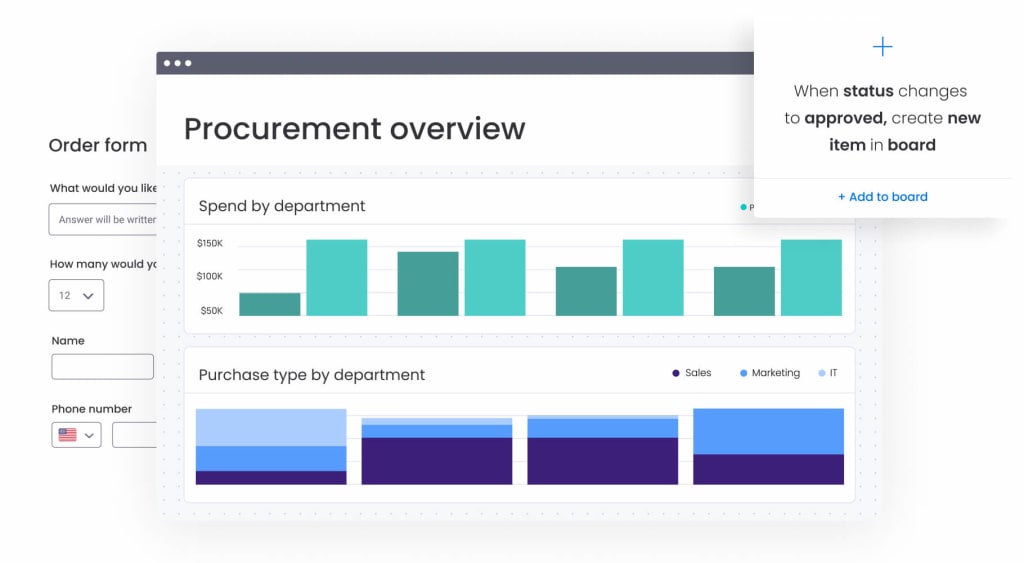
There are two types of contingencies that you should plan for: budget contingency & schedule contingency.
- Budget contingency is an additional amount of money that you allocate to your budget, so you can cover extra costs that might come up as the project progresses. If you don’t have a contingency budget, you might run into an unexpected cost that could send you over budget and risk the profit margin of your project.
- Schedule contingency is an additional amount of time that you bake into your project schedule, to allow for any unexpected delays or hiccups in your project progress. Without schedule contingency, you risk running over your project deadlines and disappointing stakeholders.
Contingency plan examples
Here are a few examples of how contingency planning could help save the day, no matter what happens:
Project contingency plan
Imagine that a key team member unexpectedly leaves the project. If you were contingency planning for this scenario, you might outline the following steps you could follow if you lost a key project team member:
- Identify who will take over the tasks of the departing team member, and what tasks still need doing
- Assess if any additional resources will be needed (such as an additional part-time project member from another team)
- Provide training sessions for other team members to ensure they can step in effectively
- Notify any stakeholders about the change and how it will be managed to minimize disruption and offer reassurance.
Business continuity plan
How about if a natural disaster disrupted operations at your primary office location? Could your business cope? With a continuity plan in place, you’ll turn things around quickly:
- Make sure all your employees have access to the necessary tools and systems so that they can work remotely if necessary
- Regularly back up all essential data to the cloud, and have a data recovery plan in place, in the event of loss of the hardware in your primary office
- Identify backup office space or plan for remote work options if the primary location becomes inaccessible
- Define communication channels that you’ll use in the event of a major disruption so that you can reach your employees to provide updates and instructions on how to proceed
Supply chain contingency plan
Do all your logistics depend on a few key suppliers? Then you should have a supply chain contingency plan in place, in case of unexpected production or shipping delays.
- Have more than one supplier for critical components, so this becomes less of a business risk.
- Maintain a buffer stock of your essential components, so that production won’t be held up by supplier delays
- Find a shipping company that offers expedited shipping options in case you have an urgent need
- Update your supplier contract to include penalties for delays and a procedure for resolving any disputes
Why contingency planning is important
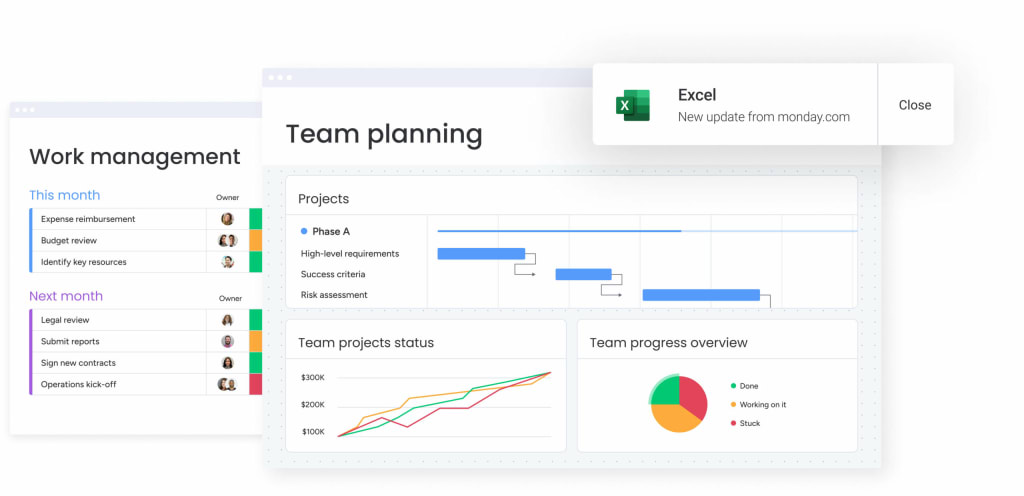
Murphy’s Law specifies that anything that can go wrong will go wrong. And any experienced project planner knows how true that is! Contingency planning can make or break your business:
It helps mitigate risk.
Contingency planning helps to identify potential risks and get ahead of them with a proactive plan. That way, even when things go wrong, you can minimize the disruption to operations and reduce your financial losses.
It makes your business more resilient.
Having a contingency plan in place enables you to respond to the unforeseen more effectively, adapt to changing conditions, and recover from setbacks more efficiently.
It keeps you compliant.
In many industries, contingency planning is mandated by regulatory requirements, so you’ll need these plans in place to avoid penalties and maintain good legal standing.
It increases customer trust.
Customers trust businesses that handle disruptions effectively. The ability to respond quickly and effectively when things go wrong will help build your reputation for great customer service.
Looking for a tool to make contingency planning easier? With monday.com, you can store all your contingency plans in a central location, communicate changes with stakeholders, and create automated workflows in response to unexpected events.
What are the characteristics of a good contingency plan?
Your contingency plan should include the following components:
List of risks
Begin by making a thorough identification of potential risks that could realistically occur. Depending on what kind of contingency plan you’re putting together, these could be all the risks that could impact your business, or the risks that could delay or disrupt a specific project or product.
For example, in terms of business-level contingency planning, you could list out:
- Natural disasters
- Technological failures
- Economic downturns
- Supply chain disruptions
- Sudden market changes
Response options
Your plan should then outline various responses that you could choose between, for each risk you’ve identified. These might be:
- Actions to mitigate the risk
- Ways to transfer the risk to another party (e.g. by buying insurance)
- Ways to accept and manage the risk
Plan of action
For each risk and response option, you should then add in a plan of action, including:
- Steps to take
- Who is responsible for each step
- Any resources you’ll need
- Any need to coordinate with other stakeholders or third parties
Communication management protocols
You’ll also want to make sure that you have a plan in place to communicate effectively with all stakeholders, including:
- Who needs to be notified
- The channels you’ll use for communication
- How often you’ll send out updates
- Any useful templates to use for messages
Trigger points
Decide in advance when you’ll activate a specific contingency response. For instance, you might have a particular threshold beyond which you’ll move to a contingency plan — such as the severity level of a natural disaster. You should also define who has the authority to make these decisions, and how the decision will be made (by committee or by chain of command, for instance.)
Testing and review
To keep your plan up to date, you should schedule regular tests and reviews. For instance, for a natural disaster contingency plan, you might want to run a drill once a year, to practice your response procedures and make sure that everything works as it should.
How to create a contingency plan
Let’s cover the basic contingency planning process and detail how to get yours up and running.
1. Map out essential processes.
What processes are essential to your business and safely delivering your product or service to customers?
If you’re a manufacturing company that ships directly to consumers, a simplified process list might look something like this:
- Getting raw materials from suppliers
- Manufacturing process
- Freight and shipping
- Packaging and warehousing
- Last-mile delivery
Looking at this list, you can see how vulnerable it is to natural disasters or even minor human errors.
Create an overview of every crucial process in your organization.
2. Create a list of risks for each process.
Once the process list is created, consider what might disrupt business continuity.
What can go wrong with each of these critical processes?
Let’s look at an example of what could go wrong with “last-mile delivery” …
- The driver can deliver single or multiple packages to the wrong address.
- The package can be damaged during delivery.
- The package could get lost at a distribution center.
- A truck full of packages could be involved in an accident.
- A flood could cripple the road system in a specific area.
- The driver could get delayed because a moose wants to lick salt splatter off the car (seriously, it’s a thing ).
And that’s only a preliminary list. Once you start thinking about it, you’ll realize how many things you rely on to avoid going wrong, even for fundamental processes.
Every business process is vulnerable to some sort of emergency or human error and requires a solid risk management process .
3. Evaluate the potential impact and likelihood of each risk.
Once the risks are identified, it’s essential to determine how they could impact your business.
Are they likely to happen? How large will the impact on your business if they do occur?
Most companies use “qualitative risk assessment” to do this.
PMI uses the following risk exposure assessment table — also called the probability impact matrix — to evaluate … the probability and impact of potential risks.
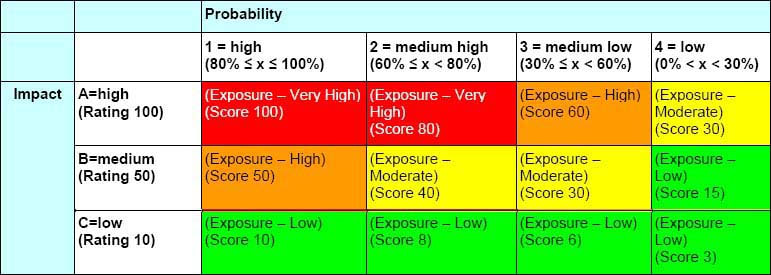
( Image Source )
First, rate the severity of the impact on a scale from 1–100. Then, multiply with a percentage based on how likely it is to occur.
4. Calculate costs and contingency reserves, and identify issues to mitigate.
The quantitative risk assessment approach is less common — but more practical — to assess the potential cost of each risk.
How much would each risk potentially cost your business? To get a better overview, add these 4 columns to the risk register template :
- Full potential loss from the event
- Expected loss from the event
- Cost of response (post-event)
- Cost of mitigation (pre-event)
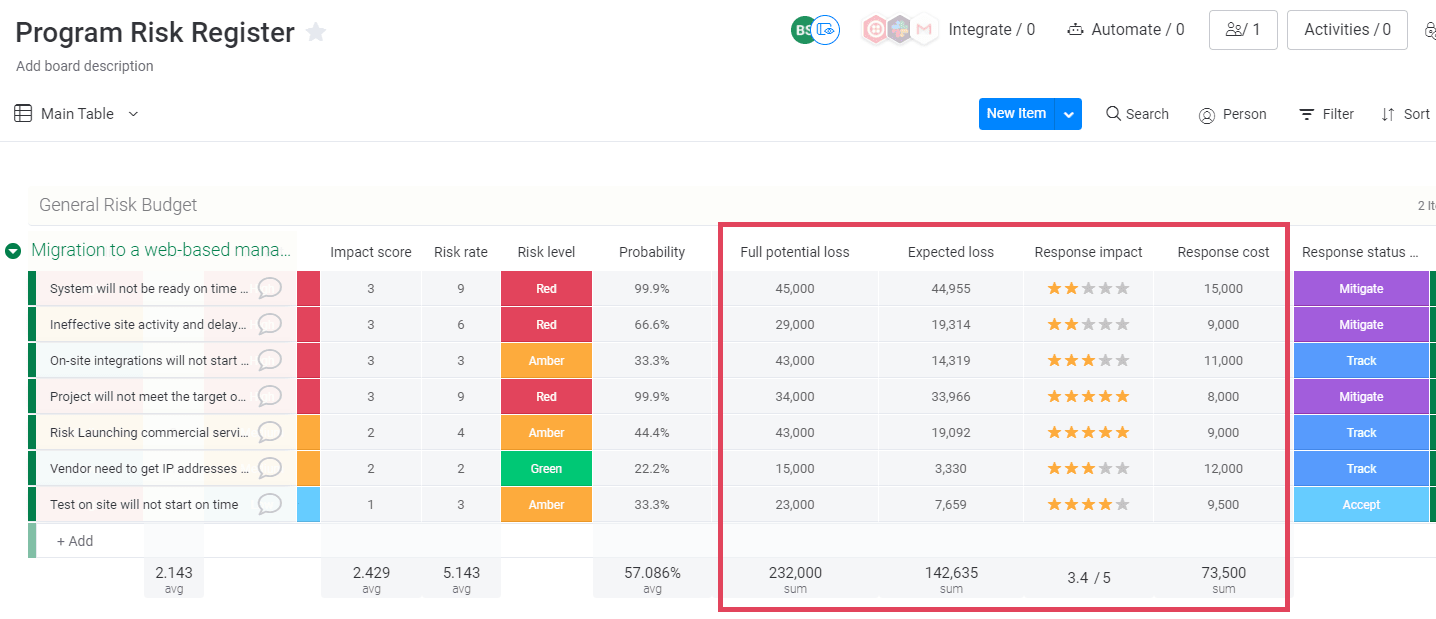
This means you can make an educated decision when budgeting contingency reserves into project plans and yearly budgets.
During the risk analysis , estimate the potential costs of the adverse event.
EXAMPLE: if your online store goes down, multiply the average online sales revenue per hour with expected downtime. Make one pessimistic and one realistic estimate.
Your hosting service may also have a flat fee for restoring sites, which would be your response cost. If these costs are unreasonably high and the event is likely, estimate the costs of a mitigation effort. In this case, it could be a firewall and extra procedures, like 2-factor authentication, an important security system , for all employees.
Budget in those costs. An accurate budget is the first part of emergency response and prevention. Without enough cash, your team won’t be able to put any response plans into action.
5. Create a response plan for prioritized events.
Create a response plan for events by exploring the following questions:
- What can be done ahead of time to minimize any adverse effects on the event? For example, backing up data, carrying extra stock, or having more employees on call.
- What can be done immediately after the event to minimize the impact? For example, ordering more from a secondary supplier, rerouting another vehicle, or bringing in on-call staff.
The specifics depend on your company’s unique processes and situation.
6. Share the contingency plan.
A contingency plan only works if it’s used when things go wrong—and that means that everyone in your organization knows to reach for the plan in times of trouble. To make sure that happens:
- Identify who needs to be aware of and involved in contingency planning.
- Choose appropriate communication methods for each stakeholder group. For instance, department heads may need specific meetings to focus on their section of the plan. Key employees might need a training session.
- Create the plan in an accessible, centralized location, such as a monday.com board. That way, everyone involved can access the plan, and you can keep it updated at all times.
- Encourage feedback on the plan, such as running an employee survey to check understanding and seek ideas for changes and improvements.
- Post reminders and updates on your shared internal communication channels.
7. Monitor and review the contingency plan.
If you want your contingency plans to protect your business, you have to keep them up to date. That means you’ll need to schedule regular reviews of the plan to check that it’s still relevant and aligned with your changing business.
Remember to communicate updates or revisions to all relevant stakeholders, and provide opportunities for additional training if needed.
Manage your contingency planning process with monday.com
Having your business contingency plan on paper is an excellent place to start. But it won’t translate to how your entire company will tackle a crisis.
That’s where monday.com comes in. Our flexible digital workspace gives you everything necessary to ensure everyone follows the contingency plan when they need to.
Use our pre-built contingency plan template to get you started
Make sure that no employee is left clueless during a crisis. Our contingency plan template has everything you need to start the planning process.
With our pre-built template, you can feel confident you’re following best practice contingency planning, so your business will run smoothly even in the case of unexpected events.
Use integrations to notify someone of an event automatically
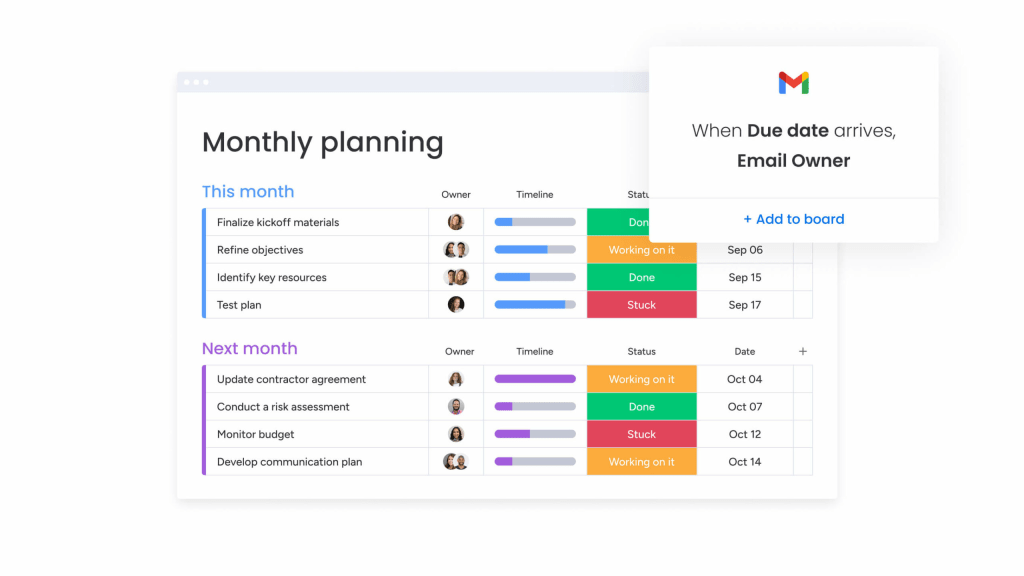
With monday.com’s powerful integrations and automations, you can respond to unfavorable events more quickly.
For example, you can immediately create and assign a work item whenever a customer submits a bug report.
This approach helps avoid another potential problem: customer service failing to report bug reports to your development team.
Monitor project status at all times in dashboards to avoid bottlenecks and domino effects.
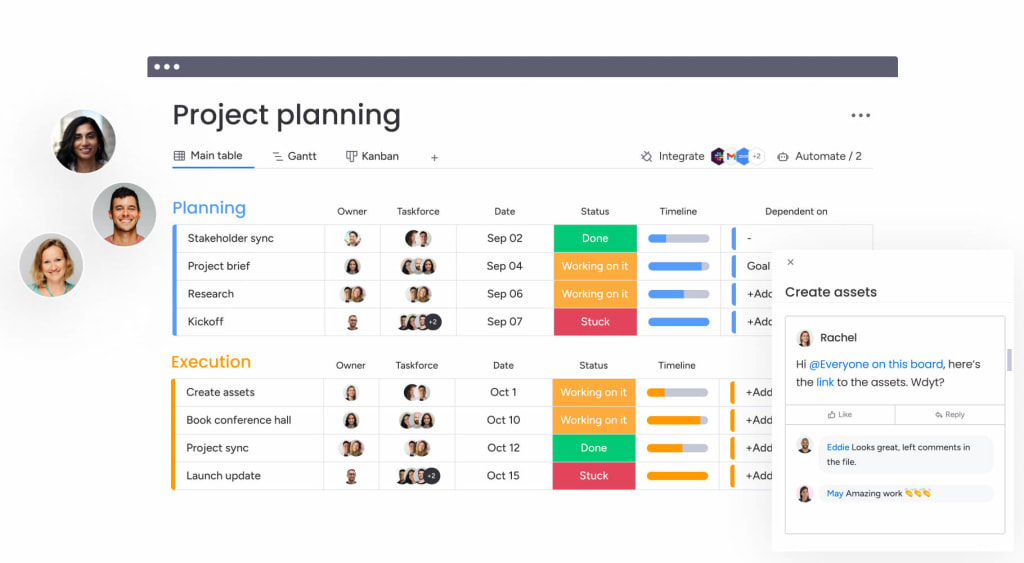
The best time to start acting is before a catastrophic event that puts your entire project or business at risk.
To do that, your management team needs a clear understanding of the project’s status at all times.
Use the 30,000-foot view every manager needs to avoid predictable project delays and failures and check that project controls are working properly.
Contingency plans are a must-have.
When starting a project or business, most people plan according to the status quo. Unfortunately, that’s a best-case scenario and not helpful in the real world.
A contingency plan helps you prepare for worst-case scenarios and keep your project afloat, should anything go wrong.
- Project risk management
Don’t miss more quality content!
Send this article to someone who’d like it.

How To Create A Smart Contingency Plan For High-Risk Projects
Contingency plans ensure projects go as smoothly as possible and maximize the chances of project success. Learn how to build one for your next project.
Table of contents
Every seasoned project manager knows from experience that projects rarely go exactly to plan. I learned the need for a solid contingency plan the hard way.
Early in my career, I would plan out a project on paper and would be convinced that I had all bases covered. But sometimes, the first unexpected challenge would rear its head from the starting gates—my perfect plan was ruined already. Then I would scramble around with the project team to deal with the fire as best we could.
This type of work invariably takes the focus off of the work that should be happening on a project, and risks you losing the trust of clients and stakeholders early on.
Enter contingency plans.
What is a contingency plan?
Contingency plans spell out actions that should be taken if an identified risk becomes reality.
Contingency plans are typically created at the start of a project —but not necessarily. A project manager will work with the team to develop step-by-step action plans for the most impactful risks identified and then do the same if new risks are identified as the project progresses.
Contingency plans also come in less formal guises. For example, when releasing a new big feature on a software platform, it’s wise to have developed a rollback plan. This means that if any problems arise from the release deemed too impactful to stay in place for any time, the team can quickly revert the platform to its pre-release state. In this case, the rollback plan is a type of contingency plan item.
Contingency plan vs. mitigation plan
As we mentioned, contingency plans are reactive—they’re meant to lay a plan for responding to an anticipated issue.
On the other hand, a mitigation plan is proactive and more about minimizing the chances of risks becoming issues in the first place.
However, the two are closely linked, and contingency plans in larger project management environments are directly related to risk plans.
Why do you need contingency planning in project management?
Put simply, you need contingency planning in project management to ensure projects go as smoothly as possible and to maximize the chances of project success.
Without a contingency, when things go wrong (which they almost certainly will), time, money, quality, morale, and trust are lost in the process of fixing things.
Contingency plans are most needed on high-risk, larger projects. Larger projects have more moving parts and are, by definition, more complex. Thus, there is a high chance of something happening that would have a high negative impact. Having a clear plan of action for big risks that turn into issues can be the difference between project failure and success.
Conversely, if you’re working on a very small project that you have done many times before with a client and technology you know well, you probably don’t need to develop a contingency plan. In this case, risk is low, and spending time on a contingency plan would probably be wasted time and money.
<cta-box><image-color="yellow">
Plan and estimate projects in Float
Whether big or small, you can plan project work in Float. Monitor your team's schedule, set budgets with five different models, and compare estimates vs. actuals all in one place.
<cta-button> Try for free </cta-button>
</cta-box>
5 steps to create and manage an effective contingency plan
1. assess the identified risks for high impact.
Review the risk register you have created, and select the risks that need to be included in a contingency plan. You can do this by assessing risks based on likelihood, impact, and severity.
While you ideally want to include all risks, start with the most impactful ones and work down the priority order. This is because often contingency planning can take a back seat in the haze of a busy project, so it’s wise to focus on the most important risks first.
2. Create the contingency steps
Work with your team and stakeholders to play a series of ‘what if’ scenario games for each risk register item selected. This is best completed as part of a focused workshop, so you can have everyone’s full attention. It’s important to get people in the zone of contingency thinking.
Here are some actions to take in this workshop:
- Create a row on a whiteboard or virtual whiteboard that starts with a risk
- Ask the team to imagine that the risk has become a reality.
- Note down the triggers that would invoke a contingency plan needing to go into action, in a separate column.
- Discuss with the group how they would react and what steps must be taken to resolve the issue.
- Note the key steps, sequence, and owners in a separate column next to each risk.
- Play back the contingency steps and confirm with the group that there are no steps missing, then move on to the next risk.
It’s important to involve a wide array of stakeholders, as each will know how particular issues should be resolved. Never underestimate who you need to develop contingency plans with.
3. Get approval from senior stakeholders and clients
Once a contingency plan is complete and you have team consensus, the next step is to seek approval from the senior stakeholders and clients. These are the folks who ultimately are the arbiters of risk tolerance for any project.
Set up a dedicated session to take them through the plan. This is important because when contingency plan overviews are tacked onto the end of another meeting, they can be skimmed over too quickly due to lack of time or, quite frankly, interest.
Make sure to communicate the importance of running through the plan for approval and make the session happen.
4. Circulate and socialize the contingency plans
Once approved, make sure to circulate the contingency plans to everyone involved in the project. Do your best to ensure that everyone is acutely aware of this plan, knows where to find it and what each of their responsibilities are for any given issue.
A slightly annoying but effective way to check that you’ve socialized the plan enough is to gamify spot checks so that people know the risks and plans. For example, create a project game with a leaderboard where you randomly ask a project team member to name the top three risks on the risk register and what the contingency plan is. You can award points to those who answer best and keep score, awarding a small fun prize to the most accurate people.
It sounds corny, but a common issue with contingency plans is that they are forgotten once created, approved and circulated. A good project manager will ensure they’re not.
5. Treat contingency plans as living documents
Contingency plans are mostly created at the start of projects, but it’s a mistake to consider them complete once the first version is created. As with risk registers, contingency plans should be classed as living documents that are constantly reviewed and updated as projects progress.
For longer projects, it’s wise to set up monthly risks and contingency plan review sessions with the project team. You will run through the current risks and contingency plans and determine if the assessment and details are still accurate or if anything needs tweaking, adding, or even removing.
When any changes are made, re-approval should be sought from senior stakeholders and clients, documented in writing.
Contingency plans are critical
Contingency plans are a critical element for large high-risk projects. They allow project teams to think about worst-case scenarios for identified risks and develop a plan that will enable them to resolve any issues as effectively and efficiently as possible.
Make contingency plans a staple for your high-risk projects. Even if you don’t need to deploy them, you can sleep soundly at night knowing that a plan is in place.
If you do end up deploying a contingency plan, you will be sure that you’re resolving issues in the most timely and comprehensive manner, in a way that your stakeholders and clients approve of and maximizing the chance of keeping your project on time and on budget.
<form>
<form-title>
Get exclusive monthly updates on the best tools and productivity tips for asynchronous remote work.
</form-title><form-caption> Join 100,000+ readers globally </form-caption>
</form>
Related reads

A simple guide to project control

Here's How to Effectively Manage Risks in Your Next Project

How To Manage Change in Project Management Effectively
Get exclusive updates on.
- Async communication
- Remote team culture
- Smart time management

What is a Contingency Plan?
Fahad Usmani, PMP
June 25, 2024
Risks are common in project management, and effective risk management is the key to completing projects. A crucial element of this strategy is a contingency plan. A contingency plan is a proactive strategy to address risks and ensure project continuity when unforeseen events occur.
Contingency planning helps manage risks, minimize impacts, and keep projects on track. A robust contingency plan can enhance resilience, protect project objectives, and improve project success rates.
In today’s post, I will explain a contingency plan, highlight its importance, describe the steps to develop one, and more.
A contingency plan is a part of risk management that involves preparing strategies and actions to address identified risks that can affect your project objectives .
This proactive approach ensures that projects progress smoothly despite unforeseen challenges. Contingency plans include the steps you need to take when an identified risk occurs to reduce the impact or probability of negative risks and increase the likelihood and impact of positive risks.
Contingency plans are integrated into the overall project plan. Effective contingency planning includes regular reviews and updates to address new risks and changing project dynamics.
A contingency plan helps you quickly respond to risks, minimize delays, control costs, protect project objectives, and increase the chance of project success.
Five Steps to Develop a Risk Contingency Plan
You can follow the following steps to develop your contingency plan:
1. Develop a Risk Management Plan
To develop a contingency plan, you must first create a risk management plan , which will provide a structured approach to defining and handling risks. This plan will outline the objectives and scope, detail the risk identification, analysis, response, and monitoring methodologies, and define roles and responsibilities.
It establishes risk tolerance levels , ranking terminology, and communication strategies to ensure all stakeholders are on the same page and understand their role and the process.
2. Identify Risks
This step involves gathering stakeholder input through brainstorming sessions to uncover potential risks. You can use SWOT analysis to examine the organization’s strengths, weaknesses, opportunities, and threats. You can review historical data and consult experts to identify common and overlooked risks. All this ensures a comprehensive risk-identification process.
3. Analyze Risks
After identifying the risks, you analyze them to determine their potential impact and likelihood. This involves assessing each risk and its potential consequences on the project objectives. You can use a risk matrix to prioritize the risks based on their severity and probability, focusing on those that pose the greatest threat or provide opportunities.
If the project is small, you can use only qualitative risk analysis to analyze the risks. However, you will also use quantitative risk analysis techniques for larger and more complex projects.
At the end of this process, you will have a list of prioritized risks.
4. Develop Risk Response Plans
Next, you will develop risk response plans for the prioritized risks. Risk response plans are different for negative and positive risks. For negative risks, you should eliminate them, reduce their likelihood, or reduce their impact. For positive risks, you should try to realize them to increase their chance of occurring or increase their impact.
After developing the risk response plans, you will assign responsibilities to specific individuals or teams (i.e., risk owners) and allocate necessary resources to ensure effective implementation.
You will use the contingency reserve to implement the contingency plans.
5. Monitor and Update
Finally, you will monitor the project progress and effectiveness of your contingency planning. If time passes and risk does not occur, you may release the contingency reserve if required. If a risk occurs, it consumes the budget; you will update the risk register.
If any unidentified risk occurs during the project lifecycle, you will manage the risk using a workaround. However, this time, you will use the management reserve.
You must regularly review the contingency plan to ensure that the plan remains relevant and effective.
Contingency Plan Vs Fallback Plan
A fallback and contingency plans aim to manage risks but differ in scope and application. A contingency plan is a strategy that outlines responses to identified risks.
Fallback plans are Plan B for risks and next-level risk-response plans. They are developed as a backup or secondary plan when the primary plan fails or proves to be inadequate. A fallback plan is activated only if the initial response to a risk or problem is unsuccessful, thus providing a predetermined, alternative path to achieve the same goal.
While the contingency plan covers identified risks and their responses, the fallback plan is a detailed second course of action for critical failures.
Read contingency plan vs fallback plan .
Contingency Plan Examples
I will now provide you with two examples of contingency plans: one for a construction project and the other for an IT project.
You develop a contingency plan for the consumables lying on the open ground. The plan says the risk action owner will bring plastic sheets and cover the consumables if rain starts falling.
This will ensure the consumables do not get wet, and you save the consumables from being damaged.
There is a chance that a key developer can leave during the peak of your project, which might affect it negatively. So, you identify a different programmer in your organization and speak with the management. If your team member leaves, you can immediately take that employee who is not busy with any important project.
Contingency Plan Benefits
The key benefits of a contingency plan include:
- Enhanced Preparedness: A contingency plan will prepare you for unexpected events, thus reducing the element of surprise and enabling a quicker, more effective response.
- Minimized Disruption: With predefined risk responses, you can continue to run the project without obstruction and minimize downtime and productivity loss.
- Resource Allocation: A contingency plan ensures that resources (e.g., financial, human, and technical) are allocated efficiently during an emergency, thus preventing waste and ensuring that critical areas are supported.
- Stakeholder Confidence: Demonstrating preparedness and resilience through a well-developed contingency plan can boost stakeholder confidence (e.g., customers, employees, and investors).
- Compliance and Reputation: Emergency preparedness can help an organization comply with legal and regulatory requirements and protect its reputation by demonstrating responsibility and reliability.
- Safety and Security: Ensuring the safety and security of employees and assets during unforeseen events can help protect the organization’s most valuable resources.
- Cost Savings: A contingency plan can help avoid the substantial costs associated with prolonged downtime and last-minute recovery actions by minimizing threats and ensuring efficient responses.
A contingency plan safeguards against risks and is a strategic asset for organizational flexibility. It allows organizations to manage risks, identify risks, analyze their potential impacts, develop proactive response strategies, minimize downtime, and maintain continuity.
A contingency plan fills stakeholders with confidence, enhances the decision-making process during crises, and develops a culture of preparedness and adaptability.

I am Mohammad Fahad Usmani, B.E. PMP, PMI-RMP. I have been blogging on project management topics since 2011. To date, thousands of professionals have passed the PMP exam using my resources.
PMP Question Bank
This is the most popular Question Bank for the PMP Exam. To date, it has helped over 10,000 PMP aspirants prepare for the exam.
PMP Training Program
This is a PMI-approved 35 contact hours training program and it is based on the latest exam content outline applicable in 2024.
Similar Posts
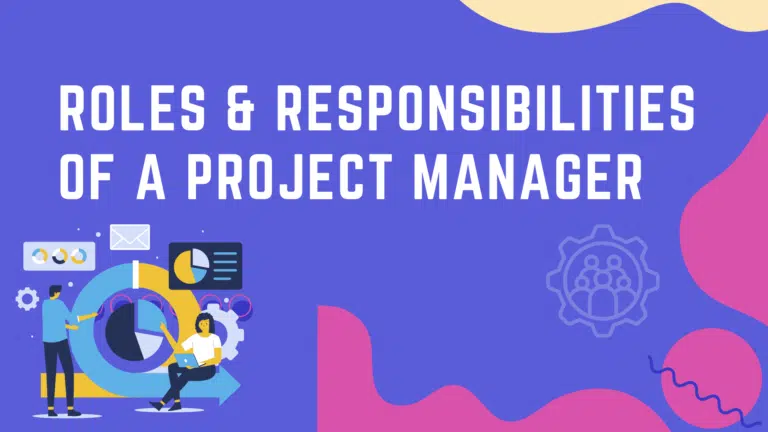
The Roles and Responsibilities of a Project Manager
The effort of project managers is behind the success of every project. A skilled project manager develops a sound project management plan, optimally uses resources, efficiently assigns tasks and roles, and completes the project with minimal obstruction, keeping all stakeholders engaged and happy. The project manager has a key role in project management and is…
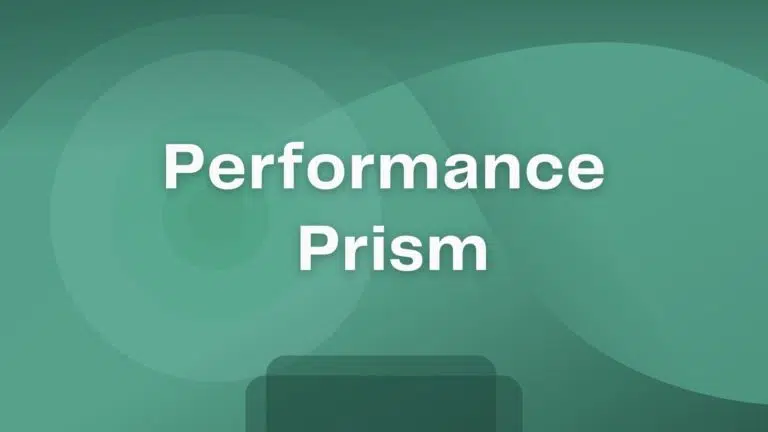
What is Performance Prism?
The Performance Prism is a comprehensive performance measurement and management framework focusing on stakeholder satisfaction. It integrates five facets: stakeholder satisfaction, strategies, processes, capabilities, and stakeholder contributions, and provides an approach to evaluating and improving organizational performance. This framework is the next-generation balanced scorecard performance management system. Adams, Neely, and Kennerley developed this concept at…

Fishbowl Window: What is the Fishbowl Conversation Method?
While reviewing the Agile Practice Guide, I learned the Fishbowl Window (or Fishbowl Conversation) method. I further studied this technique while planning a discussion session for my team and sought the best brainstorming techniques. Today’s blog post is about the Fishbowl Window Conversation method. Let’s get started. What is the Fishbowl Conversation Method? A Fishbowl…
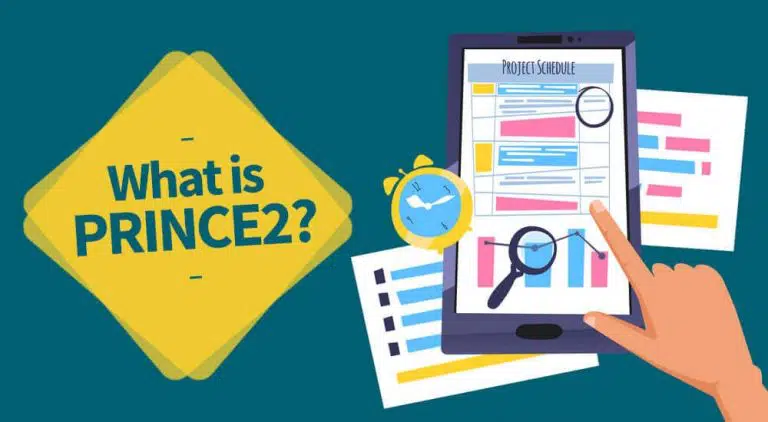
What is PRINCE2?
If you are living in the UK, Europe or Australia, you will know PRINCE2, but in North America or the Middle East, you may not have heard of it.
PRINCE2 is a project management qualification.
Both the PMP and PRINCE2 are helpful for project management professionals.
I came to know about PRINCE2 during my PMP training. My trainer was qualified in both and had helped many professionals with the PRINCE2 certification.
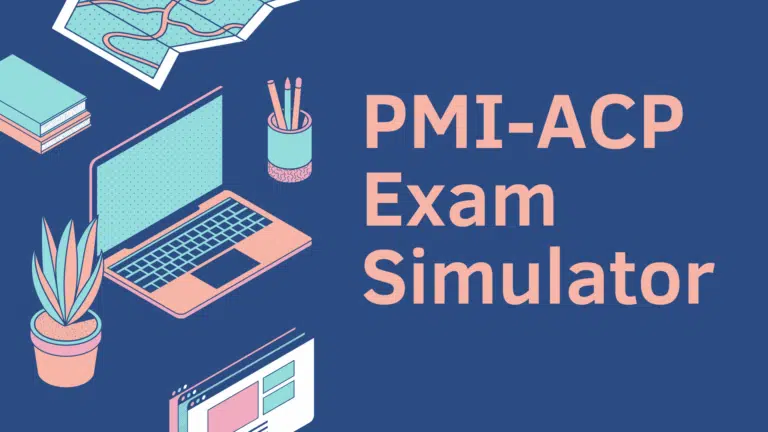
Best PMI-ACP Exam Simulators for 2024
To prepare for the PMI-ACP exam, you must practice many PMI-ACP practice questions and attempt mock tests. I recommend that you subscribe to at least two of the best PMI-ACP exam simulators so you can attempt 1,000+ sample questions and mock tests. Attempting mock tests and practicing questions is a vital part of exam preparation….
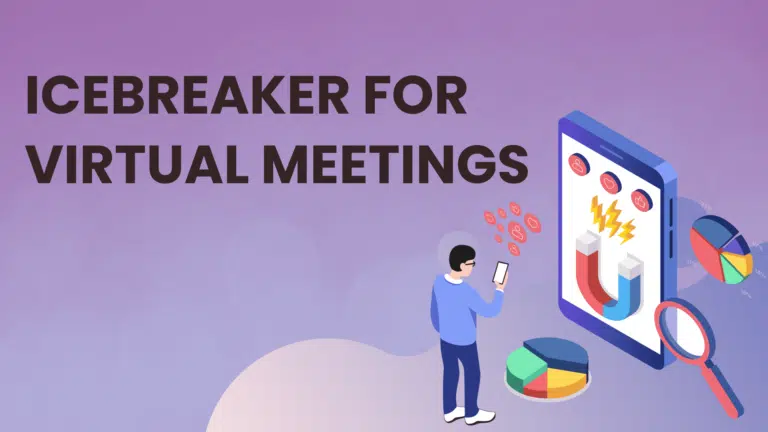
35 Fun Icebreakers for Virtual Meetings
Icebreakers are great for increasing the bond between existing team members and integrating new team members. If you have a virtual team, then you can use icebreakers for virtual meetings to bond with your team members. Due to the coronavirus pandemic, many businesses have started using virtual or hybrid teams, and in those situations, making…
Leave a Reply Cancel reply
Your email address will not be published. Required fields are marked *
Save up to 500 Hours on Paperwork 🙌 50% Off for 3 Months. Buy Now & Save
50% Off for 3 Months Buy Now & Save
Wow clients with professional invoices that take seconds to create
Quick and easy online, recurring, and invoice-free payment options
Automated, to accurately track time and easily log billable hours
Reports and tools to track money in and out, so you know where you stand
Easily log expenses and receipts to ensure your books are always tax-time ready
Tax time and business health reports keep you informed and tax-time ready
- Online Accountants
Track project status and collaborate with clients and team members
Set clear expectations with clients and organize your plans for each project
Client management made easy, with client info all in one place
FreshBooks integrates with over 100 partners to help you simplify your workflows
Send invoices, track time, manage payments, and more…from anywhere.
- Freelancers
- Self-Employed Professionals
- Businesses With Employees
- Businesses With Contractors
- Marketing & Agencies
- Accounting Partner Program
- Collaborative Accounting™
- Accountant Hub
- A Beginner’s Guide to MTD
- Reports Library
- FreshBooks vs Quickbooks
- FreshBooks vs Xero
- Partners Hub
- Help Center
- +44 (800) 047 8164
- All Articles
- Productivity
- Project Management
- Making Tax Digital
Resources for Your Growing Business
Contingency plan: what it is and why do you need it.
As much as you won’t want it to happen, sometimes your first plan can go awry. But when that happens, you need a strong backup plan you can quickly put into place.
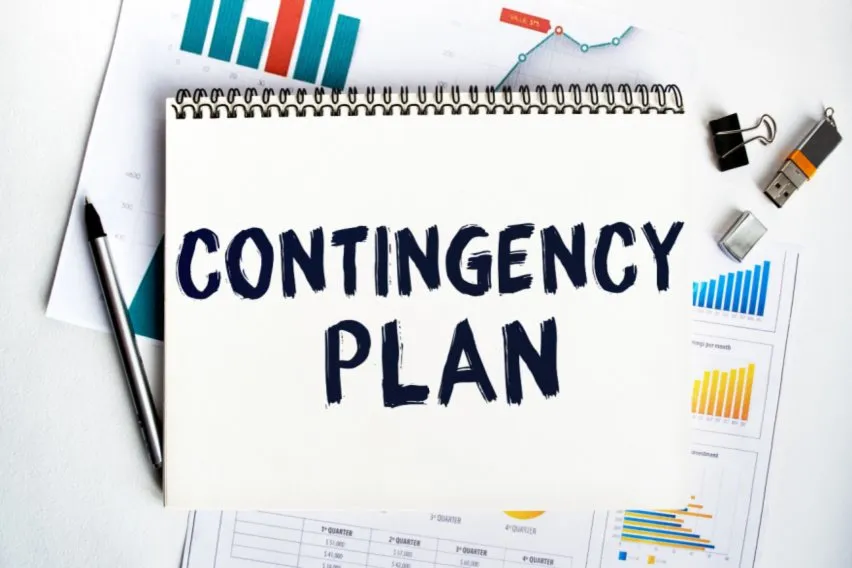
A proactive strategy helps you manage unfavourable circumstances and guarantee business continuity planning. It allows you to respond to unforeseen occurrences and resume your plans as soon as it’s workable.
But what exactly is a contingency plan? And why is it so important?
Read on as we explain what a contingency plan is, how to create one, and answer some of your questions.
Table of Contents
What Is a Contingency Plan?
How to create a contingency plan: 6 steps, contingency plan examples, importance of contingency planning, key takeaways.
Frequently Asked Questions
A contingency plan is a practical plan you must put in place if a foreseeable risk materialises. It serves as a “Plan B” for when things don’t turn out as predicted.
A business contingency plan can reduce risk and help you return to normal operations.
Contingency plans help in responding to natural disasters. Corporations develop them for disaster recovery following floods, earthquakes, or tornadoes.
Backup strategies are crucial for businesses to use when things go wrong. A contingency plan could, for instance, spell out what you’ll do if your chief rivals merge or how you’ll change course if you lose a significant client.
It could even cover less damaging, but impactful situations, such as your office power going out during the workday.

The contingency planning process may go something like this:
1. Create a List of Your Integral Processes
What procedures are crucial to your company’s operation and the secure delivery of your goods or service to customers? If you were a tech manufacturer, then your list of processes may include:
- Getting materials from suppliers
- Manufacturing
- Warehousing and packaging
- Distribution
It’s clear to see that there is a lot of potential for risk in this list of processes. And as the company is in the tech industry, the chances are that the material will be expensive to replace.
2. For Each of Your Processes, Create a List of Possible Key Risks
Once you list your processes, think about company continuity. What might impede these vital procedures? What could go wrong?
Take distribution, for example:
- The driver may deliver one or more packages to the incorrect address.
- Delivery mistakes might cause package damage.
- A package could go missing at the distribution facility.
- A package truck might get into an accident.
- A flood could make the local road network unusable.
This step analyses the vulnerabilities and the financial and operational consequences. It considers the impact, severity, and risk of recurrence for the company.
3. Figure Out How Likely Each Risk Is and the Potential Impact
After identifying the risks, it is crucial to determine how they might affect your company.
How likely are they to occur? How much of an influence would they have on your company? Most businesses do this using a risk assessment.
A risk assessment can identify important hazards and address them using response and prevention. This is part of best practice contingency planning.
4. Create Individual Contingency Plans for Your Highest Risks
Make a backup plan for each danger you’ve determined to be significant. Create a brainstorming session with your team to come up with a plan of action in case the danger materialises as part of that contingency plan. Each strategy should outline all the actions you must take to resume regular operations.
Information about the following should be in your contingency plan:
- The unexpected events that will bring about this strategy
- What the immediate response should be
- Who needs to be informed and involved
5. Calculate the Cost of Issues
Now that you have your list of risks, and you know how likely each risk is thanks to your risk assessment, you need to look at the potential costs. What possible financial loss might each risk cause to your company?
There are several ways to do this process. Although it will depend on what sector your business is in and what your processes are. It may be simple, like taking the cost of your at-risk materials and calculating the monetary damage. This allows you to make informed choices when making project plans and annual budgets.
Calculate the expenses of the unfavourable occurrence during the risk analysis.
Doing this means that you can weigh up the cost of preventing the risk vs the risk actually happening. For example, you wouldn’t take out expensive yearly insurance for a product that would be cheap to replace. But you would want to take out insurance on high-priced assets such as machinery.
6. Make People at Your Business Aware of Your Plans
Share your backup plans as soon as you have them written. Make sure everyone is aware of your plan so that you can respond quickly and effectively when the time comes. Keep your backup plans in one location so that, in case of an emergency, everyone can immediately access them.
Create a project on a workflow platform so that everyone has an instruction manual for executing it.
Here are two examples of a type of contingency plan:
Natural Disaster Contingency Plan
Despite the rarity of large earthquakes, it could be disastrous if you are unprepared when they hit. This is why backup plans are so important.
But things such as flash floods or electric storms causing a power outage are more common. So it’s important to have a plan in case disaster strikes.
The following could be part of a government earthquake contingency plan:
- The details of the individuals assigned to undertake swift and effective responsibilities.
- Methods for instructing the populace on how to react in the event of an earthquake.
- A schedule for first responders.
Hardware Contingency Plan
It is crucial to ensure the safety and security of your information systems if, for instance, your organisation relies heavily on data. Have an emergency plan in place in case something goes wrong, such as a power surge damaging your servers or a hacker trying to access your network.
A company’s backup plans for a data breach may include:
- Steps to follow to get the data properly secured again.
- Contact details of whom to contact about the implications of the data breach and how to protect their investment.
- A schedule to record the steps being taken to remedy the breach and how to prevent future data breaches.
Having a contingency plan is essential for risk management.
Any contingency plan should help to resume regular business operations as soon as possible in the wake of an unexpected event. A backup plan protects resources, identifies personnel, and designates tasks to help with recovery.
Have a backup plan in place for every department in your organisation. It should address environmental risks, like floods, outages, and leaks. It should also outline obligations for carrying out those tasks in the event of an incident.
Contingency plans give an organisation a framework for evaluating disruptive occurrences. Plus, the steps needed to recover from them. The less harm to the company and its employees, the quicker the recovery is. Maintaining a company’s finances, competitive position, and reputation requires quick recovery.

A contingency plan is beneficial if something goes wrong. It identifies potential issues, instructions on what to do in the event of an emergency, and prevention strategies. A proper risk management plan can prepare anyone to handle issues that may arise. This is true even if the person with primary responsibility isn’t present.
Design a strategy for identifying and resolving any problems that may occur. It could be a mitigating factor in the event of prosecution, and failing to have one could lead to a higher fine, as shown by recent convictions.
FAQs on Contingency Plan
What is a risk contingency plan.
It is a thorough plan for protecting your company from hazards and emergencies from the outside, such as natural disasters.
What Are the Components of a Contingency Plan?
A contingency plan comprises 3 things:
- An analysis of what could occur
- A strategy based on the analysis
- The activities that prepare for the best outcome
What Is the Purpose of a Contingency Plan?
A contingency plan enables a company to resume regular business operations as soon as workable in the wake of an unexpected incident.
What Is a Good Contingency Plan?
A strong contingency plan should include every scenario that could interfere with operations.
RELATED ARTICLES

Save Time Billing and Get Paid 2x Faster With FreshBooks
Want More Helpful Articles About Running a Business?
Get more great content in your Inbox.
By subscribing, you agree to receive communications from FreshBooks and acknowledge and agree to FreshBook’s Privacy Policy . You can unsubscribe at any time by contacting us at [email protected].

Project Contingency: The Ultimate Guide
This blog is reader-supported. When you purchase something through an affiliate link on this site, I may earn some coffee money. Thanks! Learn more .
Your new project was approved for funding. That in itself is a huge step. You wouldn’t believe the number of project managers I speak to on mentoring calls who struggle to get their budget approved.
You can’t do much on a project without some funding behind you.
However, before you start the celebration too soon, there are always details to check first.
What exactly got approved? How much do you have and what boundaries and constraints come with it? You will likely have lots of questions. Not least: is it enough? Does the funding include contingency? (Because you put some in the request, right?)
If you’re wondering what budget contingency is, then you have come to the right place. This article will explain project contingency, how to calculate contingency and how to manage it within the scope of your projects.
What is project contingency?
Project contingency is the additional resources put aside to address potential risk and uncertainty in a project.
There are two types of contingency typically used on projects:
- Budget contingency: Additional funding to deal with problems, realized risks relating to a specific event
- Schedule contingency: A buffer of extra time in case of schedule delays (not that you would ever pad your estimates?)
The amount of each of these will be documented in a project contingency plan. In practice, that could mean a paragraph or two in your project plan or risk management plan. The detailed figures will go into the budget or the schedule management plan.
Why is contingency important?
Only 62% of projects complete within their original budget, according to PMI’s 2021 figures. No organization wants a cost overrun to scupper their budget. However hard you try, you simply can’t predict the future and anticipate every problem.
Contingency allows us to present final budget estimates as a range, as you can see in the figure below.
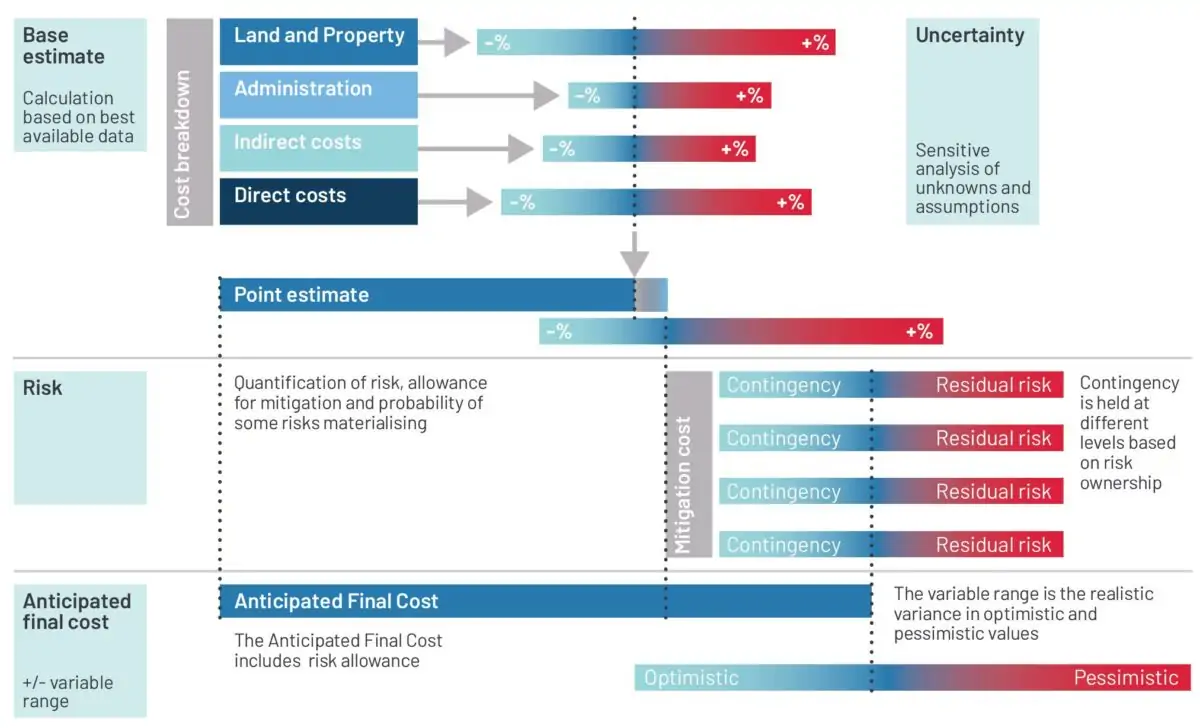
Take the cost baseline, add in the mitigation costs for dealing with ‘general’ risks and residual risks, and that will give you the final cost of the project – the IPA Guidance is specifically for construction budgets but the general premise is useful as best practice for all kinds of projects.
So risk is critical to understanding contingency: that’s the first step.
Read next: 14 Common Project Risks – perhaps some of these will contribute to your contingency position?
Why risk matters
It is not practical to document the infinite number of things that could go ‘wrong’ on a project. As a project manager, our reality is that we expect the unexpected to happen.
From your previous experience, you may have a general idea of what is most likely to happen. Even if you do, you still need a plan and potential options to address things when they do happen.
That’s where project contingency comes in. Think of it as the promise of additional resources (typically time and/or money) allocated in a project to address possible risks and uncertainty. The reason we do this is to help increase the likelihood that the project will be completed at or below the approved amount for funding.
Schedule contingency might take the form of additional time or a buffer in a project schedule . For example, on a project, we might factor in an additional several days or even weeks to accommodate unforeseen delays.
Project scope and complexity can also be a factor. For example, a high complexity project using a new technology may require additional time to complete and funding to address any unexpected challenges.
How to calculate contingency
The basic process for calculating project contingency is:
- Determine the level of risk/uncertainty in the work (at work package level if you are using work packages).
- Work out how much money to put aside within the overall project costs, based on the risk.
- Ringfence that amount until it is needed.
- Contingency reserves are available at Work Package and Activity levels (see image below).
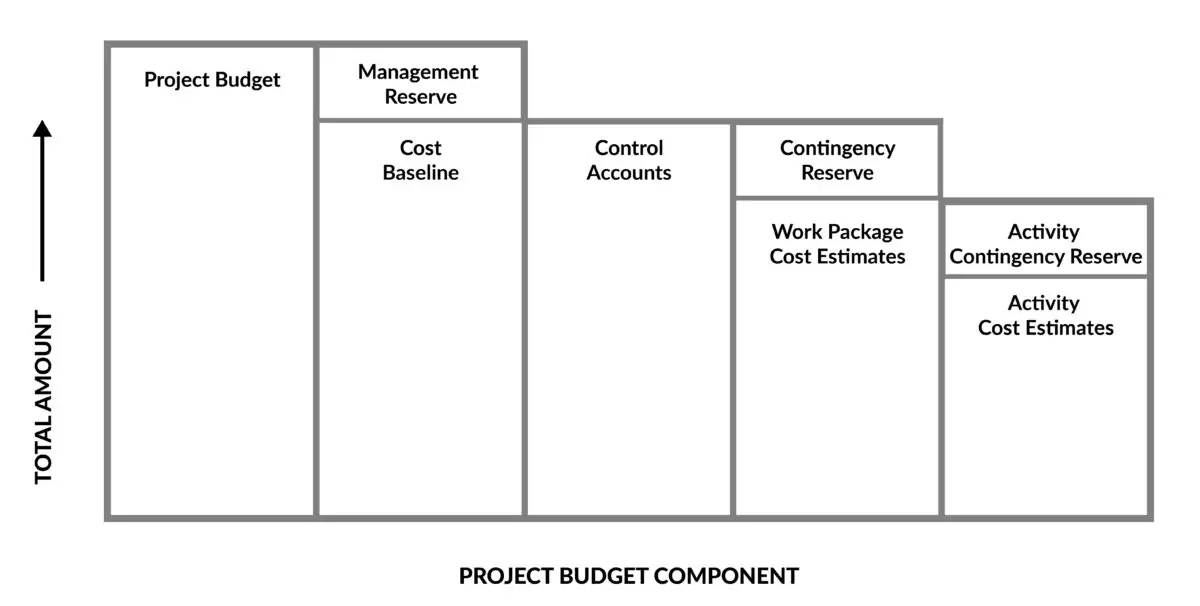
While understanding the risk profile of your project is important, there are always new risks and unknown risks that you will face. Think of contingency as a buffer to offset unexpected events or unforeseen costs.
4 Common methods for calculating contingency
The UK Government’s Infrastructure and Projects Authority launched Cost Estimating Guidance for infrastructure (construction) projects in 2021 which covers the whole process for creating a budget from estimates, of which contingency calculations are a part.
The guidance says:
“Projects should reserve funding to address the impact of risks materializing. This funding should be proportional to the impact of the risk and adjusted to the probability of the risk materializing. The project contingency is therefore cost estimated at a probability value. The project team must evaluate an optimistic, median and pessimistic spend to face risks.”
Let’s look at 4 common methods for calculating those costs for your contingency plan – don’t worry, there are some easy wins here as well as more complicated calculations.
1. Easy method: Use established contingency levels
Some businesses have established contingency levels that are acceptable for projects. For example, some might simply add 5% to 10% to the base cost of a project. For a $1 million project, this would be an additional $50,000 to $100,000.
This is what I use. If in doubt, stick 10% on your budget. Make sure it is called out transparently in a line on its own so it is clear that it is contingency funding.
In my project budgets, we call this ‘additions’. It’s an amount of money that acts as a construction contingency because on build projects there is nearly always something that we uncover, like the need for a new network point, or air conditioning pipes. Stuff you can’t see until you pull down the existing walls — that kind of thing.
Advantages: Quick! You end up with some contingency funds instead of none.
Disadvantages: Barely any probability-related thought has gone into this at all. It’s just guessing.
2. Robust method: Risk analysis
Use the risk management process to carry out a risk assessment. Then work out the risk budget required to adequately address each risk.
Tip: Use subject matter experts at this point to establish what cost contingencies might be needed to deal with the risk. They can give you an estimated amount for key items on the risk register. They can also give you an indication of the degree of uncertainty associated with their estimate. Previous projects are a good source of information.
Project managers create and maintain a risk register throughout a project’s lifecycle. The risk register is a summary of all potential risks that might occur during a project’s lifecycle, and that could have undesirable consequences on a project’s cost, schedule, etc.
In this model for contingency planning, the total value of those identified risks match the total contingency allocated to the project. This helps provides justification for keeping those contingency funds in reserve. An example is shown in the table below.
| Resources lack training | Training | Additional cost and time for training | Provide training after kick-off | $5,000 |
| Misalignment on scope – customer requests changes | Scope | Additional hours for re-work | – Discuss at kick-off – Get sign off for intermediate deliverables | $50,000 |
| Scope unclear for 1 deliverable due to incomplete design – rework required | Scope | Additional hours for re-work | Get customer feedback on prototype | $10,000 |
Here’s how to assess the potential cost impact of a risk:
- Work out the full potential cost you would incur if the risk happened.
- Calculate the expected cost or expected value based on how likely it is to happen (value = probability x loss). This is your risk exposure.
- Calculate the cost of management actions required if the risk occurred.
- Add the figures together for all risks to create your contingency budget.
In other words, this way of calculating contingency uses the risk exposure as a way of working out the additional costs that may be required to meet the project objectives if the worst happens.
Advantages: Logical. Easy to explain to the project sponsor and team members.
Disadvantages: Time-consuming to do that level of analysis on every risk.
Tip: If your project doesn’t warrant doing that level of analysis on every risk (because over here in real life, we have barely any time to dedicate to full risk management while trying to juggle multiple projects and not burnout), then do it for the major risks and use the % of project base estimate for everything else.
3. Advanced method A: Monte Carlo analysis
An advanced method for calculating project contingency is to quantify risk using a method like Monte Carlo simulations. To use this method, you need to understand and estimate the best, worst, and most likely effort needed to complete each task in a project.
Monte Carlo-based software randomly combines those different estimates to determine the overall probability that the entire project will be completed within a specific budget.
Advantages: You can select the desired probability or confidence in the final budget that is consistent with your desired risk tolerance. Your contingency is likely to be accurate for your needs.
Disadvantages: Creating those estimates and running the Monte Carlo simulation takes time and vetting the estimates is also critical. This option needs a lot of thought, time investment, and someone skilled at using the software. It’s overkill for small, low-risk projects.
4. Advanced method B: Class of estimate
Another advanced method for working out your contingency reserve amount is to define the class of estimate for your project budget (the level of certainty).
This is typically based on guidelines for different classes of cost estimates, as explained by the Association for the Advancement of Cost Engineering (AACE) and their classification of estimates.
The classifications are based on specific criteria for the level of project information available (data used as the basis of the estimate). More detail means a tighter tolerance or increased likelihood that the project cost will fall without the desired range.
This method can be used with factored estimates that combine high-level or rough estimates, vendor quotes, and even previous costs from similar projects.
Advantages: You can perform the minimum level of work, engineering, or effort needed to meet the desired estimate range. For example, a Class 3 estimate might have a cost estimate range of -10%/+30%, while a Class 5 estimate has a range of -3%/+15% but Class 5 does require additional work and time to better define the project and achieve the tighter estimate tolerance.
Disadvantages: If you had to read that section twice, you are not alone! This is a specific and complex way of working that will suit certain projects but if you don’t already know your project falls into that category then skip this method.
Note: A management reserve is different from the amount of contingency you have. Management reserves have a different call-off process and might be used for unforeseen changes.
How to manage contingency funds
Ongoing review and validation of project risks and associated contingency should occur throughout a project.
In the example in the table above, the 3 main risks listed have a total impact of $65,000. If one of the risks no longer applies, let’s say resources do not need training, then the contingency can either be reassigned or released from the project.
If released, the contingency would become $65,000 – $5,000 (less the proposed training budget) = $60,000.
Experience shows that it is easier to release contingency than to add it back, so be sure to keep that in mind. Don’t hand back funding unless you are sure you won’t need it later!
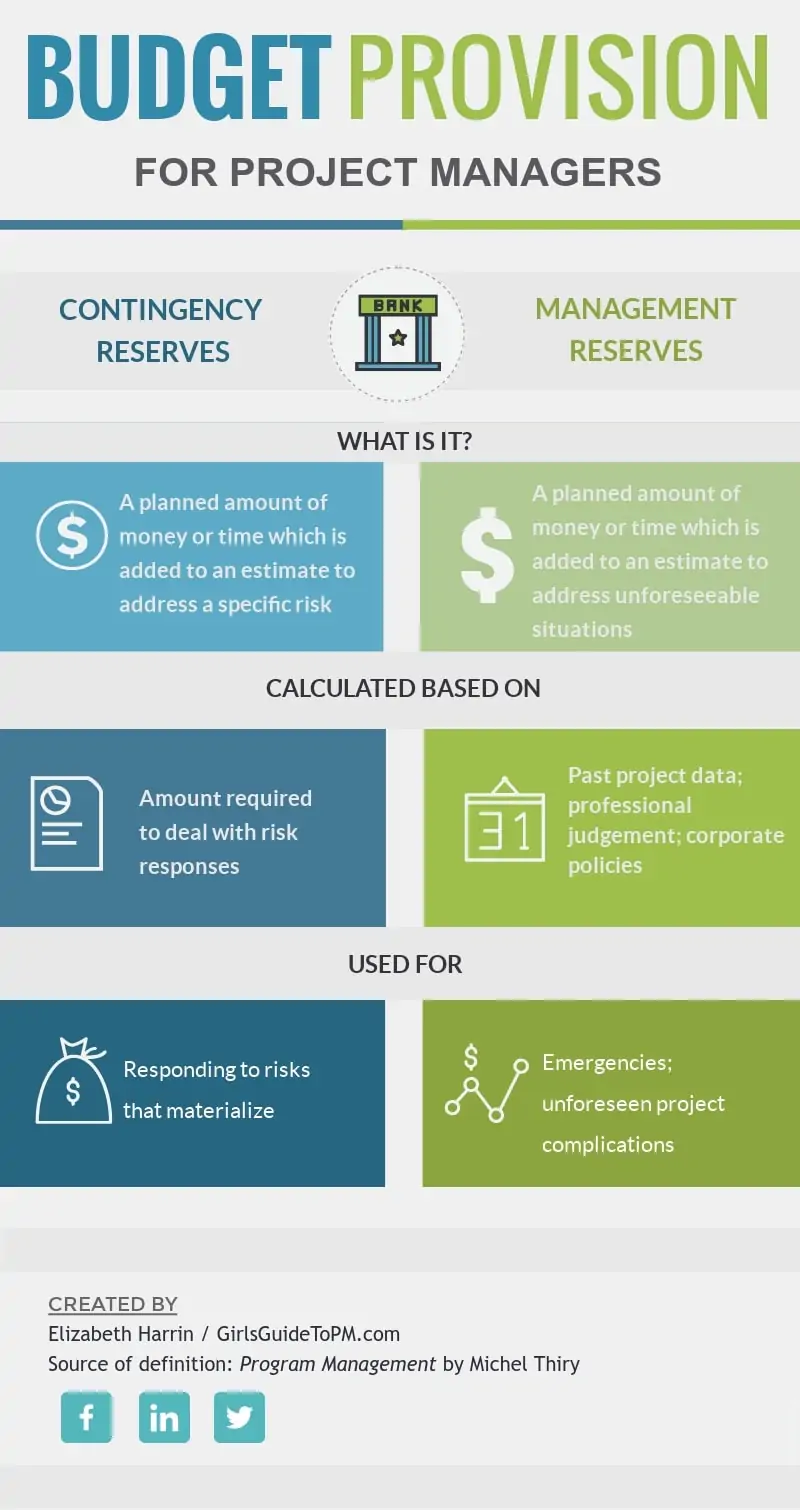
Considerations for managing contingency
In addition to cost and schedule impact, the timing of potential risks should also be considered. You might assume that as a project nears completion that all contingency could be released.
The IPA Cost Estimating Guidance says that as a project:
“becomes more defined and scope and risks are further identified, the size and allocation of contingency must be revised.”
However, pay close attention as some projects have risk that is heavily weighted towards the end of the project. For example, if there are deliverables to review and acceptance does not occur until the end, there is a chance that some updates or rework may occur towards the end of a project.
Be sure to understand the timing of risk on a project and communicate that so that everyone is aligned on expectations.
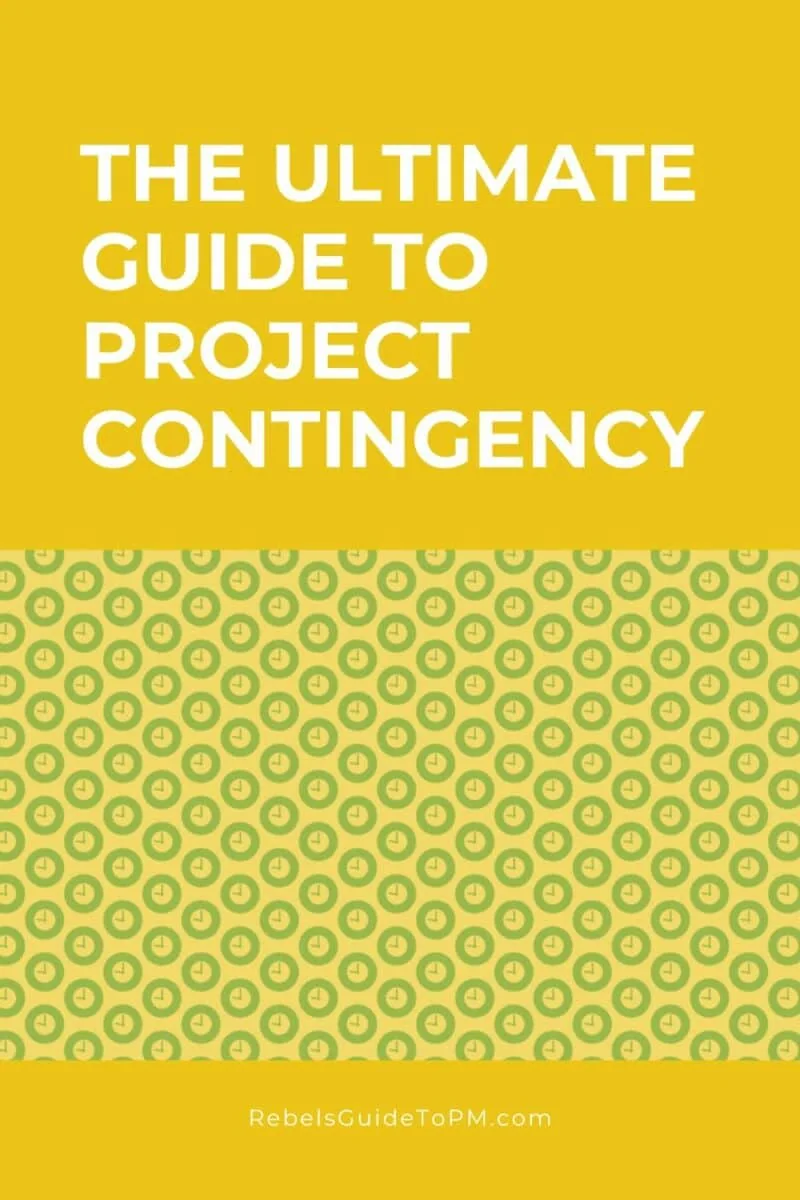
How to access contingency funds
On one project early in my career, I wanted to use some contingency funding. I had a specific reason, and I knew the money was there. At least, I’d been told that it was.
But I couldn’t get it.
It seemed like no one knew the process for accessing the funding. Where were my contingency funds?
I learned to check the process for accessing the contingency budget (and ideally, to be in charge of it).
Your organization might have or require separate documentation for contingency release. There may be a formal process for requesting and allocating contingency funds if you do not manage them. This may be noted in the project risk register, or via a separate document or process.
Regardless of the process, you want to provide traceability that explains how and why the contingency funds were spent. That traceability is important to ensure transparency, in the event of a project audit, for potential stakeholder questions, etc.
What is a contingency plan?
What happens when a risk does occur? Technically, at this point, it becomes an issue. Before that ever happens, a good project manager, along with the support of their team, will have developed what is called contingency plans.
A contingency plan is the specific action (or actions) one takes if an identified risk occurs. It’s your Plan B. At least one or more contingency plans should be identified for each known risk.
For example, in the table above, resources lacking adequate training were identified as a risk. The impact of that risk could be that people will spend additional time due to inefficiency or perhaps they will need to do some rework.
The contingency plan for that is to provide training (at a cost of $5,000) to ensure technical alignment and higher efficiency. If the team does need training, the risk becomes an issue, and the contingency plan swings into action to provide that training at a cost of $5,000.
Project schedules can also make use of contingency plans. This is typically in the form of additional days incorporated in scheduled activities.
For example, for a project phase that takes 12 weeks, we might add roughly 10% (let’s say 5-7 additional working days) of contingency in the schedule. This is time to cover unknown technical issues that need to be addressed and might otherwise cause some delays. By building that time into the schedule , we can reduce potential schedule exposure.
Quick questions
What contingency should a project have.
There is no single answer to how much contingency a project should have. The level of contingency funding or schedule contingency is determined by how risky the project is.
How is project contingency calculated?
There are a few ways to calculate project contingency. A common and reliable method is to assess the mitigation costs for all known risks and use that as the basis for putting a value on risk exposure. That then becomes your contingency allowance figure.
What is an example of contingency?
Here’s an example of contingency: If there is a risk that the cost of a component part will increase, we could use past increases to forecast potential cost increases and include that in the contingency budget.
Your next steps
We have defined contingency, reviewed ways to calculate it, explained where to document it, and how to provide a contingency plan for when things do occur. Now it’s time to put that into action.
Your next steps are:
- Review the specific nuances of your project that are dependent on the project scope so you understand where the risk is.
- Make sure you have an existing cost estimate .
- Review your company’s financial guidelines for contingency (be sure to ask your financial contact)
- Start preparing with the Project Workbook and Budget Tracker .
However, this should give you enough information to get started and give you a better idea of what to expect through project completion. Now you can go out and celebrate securing your funding!
Read Next: 4 Categories of Project Management Methods
Project manager, author, mentor
Elizabeth Harrin is a Fellow of the Association for Project Management in the UK. She holds degrees from the University of York and Roehampton University, and several project management certifications including APM PMQ. She first took her PRINCE2 Practitioner exam in 2004 and has worked extensively in project delivery for over 20 years. Elizabeth is also the founder of the Project Management Rebels community, a mentoring group for professionals. She's written several books for project managers including Managing Multiple Projects .

- IE Corporate Relations
- IE University

From Long-Term Planning to Contingency Planning
In an uncertain situation like the current COVID-19 crisis, a contingency plan is the key to being able to keep providing services. Organizations of all sorts—governments, private companies, universities, etc.—need to followed a detailed process that will allow them to plan the best possible response to the various scenarios that may come to pass. In this article, Borja Santos outlines the process of designing a contingency plan—which should include a basic plan, contingency-specific responses, and support functions—and discusses the need for regular updates and improvements.
The crisis due to COVID-19 makes us live in a context full of uncertainties. Many of our countries are at different levels of quarantine and lockdown, and whether we work for a government, a private company, or a university, we are not sure how we will have to provide our services or carry out our planning.
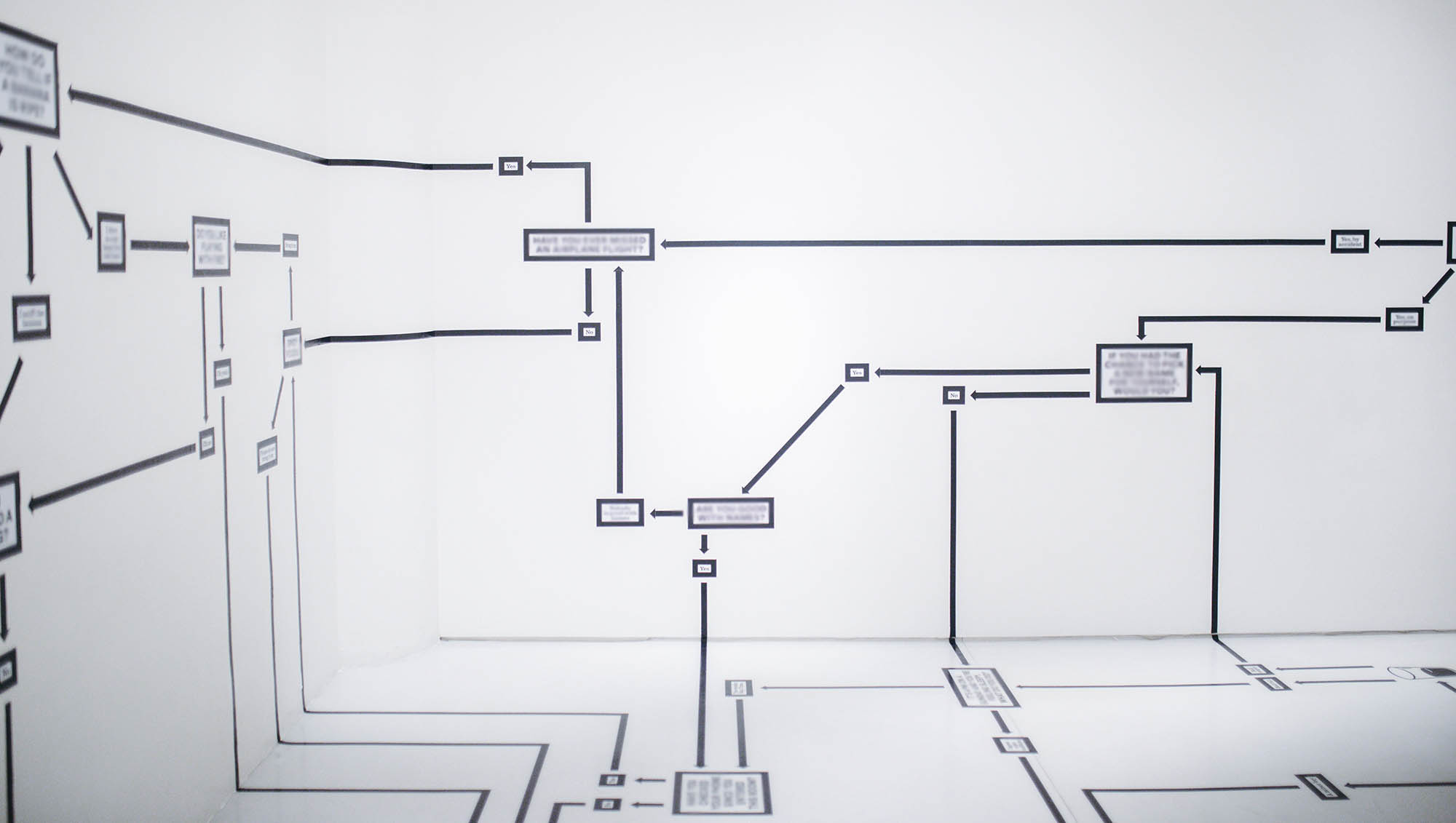
In some countries, crises like diseases, drought, or floods happen recurrently but their impact varies every year. Thus arises the question of how best to plan a response to a situation where uncertainties are present. Contingency planning is an effective approach and it is advisable to know how to design a plan of your own.
According to the United Nations Office for Disaster Risk Reduction ( UNDRR ), a contingency plan is a management process that analyzes specific potential events or emerging situations that might threaten society. These plans establish arrangements in advance to enable timely, effective, and appropriate responses to such events and situations.
Contingency planning is a process in which stakeholders work together to identify potential crisis scenarios and develop a shared understanding about the risk. This style of planning helps establish a common set of principles and mechanisms as to how an organization would make decisions during a potential crisis.
The team should build relationships, collaboration, and confidence, which can lead to understanding, with the aim of obtaining a better response in the event of an emergency.
Preparation of the plan
In order to design and implement a contingency plan, it is important to choose a collaborative team that includes experts from all relevant departments or units of your organization. It should also include civil society representatives if the plan targets a particular region. The team should build relationships, collaboration, and confidence, which can lead to understanding, with the aim of obtaining a better response in the event of an emergency. The process of preparing a contingency plan is shown in the following chart.
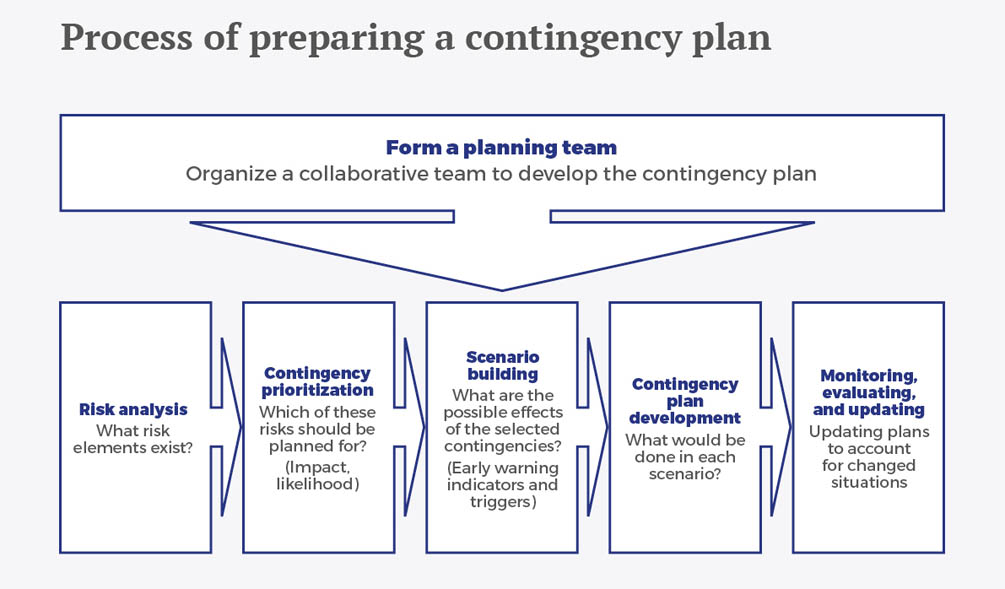
How is it structured?
A contingency plan can be divided into three main sections:
- Basic plan: The basic plan provides an overview of the institution or company’s approach to emergency operations and describes the purpose, scope, and general emergency coordination (information and communication, finance , logistics, etc.).
- Contingency-specific responses: This section describes the best and worst scenarios for the contingencies prioritized, establishes early warning indicators and triggers, and defines the resources and functions required for particular hazards.
- Emergency support functions: This section describes the expected mission execution for various functions (e.g. communication, finance , IT, marketing , etc.) and identifies tasks assigned to the person responsible in each case.
Contingency planning is a process in which stakeholders work together to identify potential crisis scenarios and develop a shared understanding about the risk.
First, the basic plan should describe the most important aspects of any emergency coordination. Who has the authority to activate the plan or to take particular decisions? Who should be responsible for directing different response activities (and who can they delegate responsibility to)? How will they coordinate amongst themselves? For example, at IE University, there is a task force formed by representatives of the different departments, who meet on a daily basis and coordinate to make decisions based on the new circumstances.
Furthermore, it is important to describe information and communication management. How will information will be collected, analyzed, and disseminated? What are the main mechanisms used to identify and assess the needs of your community, your clients, or your staff? What are the alert and warning mechanisms at the institution?
It is also very important to define the possible emergency funding sources and the logistics and management mechanisms used to identify and acquire resources in advance and during emergency operations, especially to overcome gaps in capacity. What resources are needed? What resources are available? What are the different processes and timelines for allocating resources and who oversees these processes?
Finally, we need to know the main aspects and factors of our risk. What is the location, intensity, frequency, and probability of the main hazard(s)? How great is our exposure and vulnerability? What are our main coping mechanisms and capacities?
Specific responses
Second, we need to analyze contingency-specific responses. We need to provide details of the probable impact(s) and negative consequences of each contingency, that is, the characteristics of the different potential scenarios, including the number of people affected in different population groups and the various negative effects and losses for society or for your institution or company. Knowing the losses gives us a clear idea of the magnitude of the likely impact and allows us to estimate various planning assumptions for likely needs, in terms of both response capacity and resource needs. It is very important to plan not only for a likely scenario but also for an undesirable scenario.
This section should also provide specific early warning indicators and triggers for action based on realistic startup times for emergency interventions. A number of quantitative or qualitative early warning indicators and triggers should be identified for each scenario—for example, different levels of a state of alarm and how they would affect society or your company.
It is very important to provide information about the resources required to respond to the emergency in each scenario.
Finally, we should indicate which emergency support functions will be activated for each scenario (and each hazard, if there is more than one).
It is very important to plan not only for a likely scenario but also for an undesirable scenario.
Support functions
Third, we must take into account the emergency support functions (ESFs). We need to define the critical operational functions necessary for an emergency response. Each ESF should include a description of the processes, roles, and responsibilities that the respective departments or stakeholders should carry out for preparedness and to achieve early recovery from a likely crisis situation. ESFs should focus on specific responsibilities, tasks, and operational actions needed for each function. We can have different ESFs depending on the context. If we are a national government, we might have defense, health, transport and mobility, foreign affairs, economy, and others; if we are a sales company, we might have marketing , communication, finance , and IT; and if we are a university, we might have admissions, faculty and teaching, student communication, etc.
Each ESF should include a checklist of actions identifying and describing the actions that will be taken in the event of an emergency (response and early recovery) as well as activities to be taken before the incident (preparedness).
Regular updates and improvements
Finally, contingency plans should be adapted to the current situation, as we are seeing nowadays with the COVID-19 outbreak. As it appears that this situation will last for several months, institutions and companies should design and test their contingency planning processes. This will allow them to make efficient, effective, and equitable use of resources.
The situation is uncertain and the potential scenarios are numerous. Even though we are already responding to the current emergency, we can still think about potential scenarios in the near future. This may not be traditional long-term planning, but it is a strong contingency planning proposal.
© IE Insights.
Expect the Unexpected in French Politics
U.s. debt spiral: a looming threat to global economic stability, the many paths of innovation, time to use the f-word for trump, would you like to receive ie insights.
Sign up for our Newsletter
RELATED CONTENT

Asia’s Prospects
Asia is facing a watershed moment in its climb up the economic ladder, write Simon Commander and Saul Estrin.

It’s a Matter of Trust
Do you have an efficient organization.

How to Manage Specialized Workers

5 Principles for Manufacturers to Survive and Thrive in the 4th Industrial Revolution

Finding Personal Strength in Times of Workplace Uncertainty

How to Listen and Lead in Evolving Markets

How to Manage Your Star Employee: Bartomeu vs Messi
Latest news.
We use both our own and third-party cookies to enhance our services and to offer you the content that most suits your preferences by analysing your browsing habits. Your continued use of the site means that you accept these cookies. You may change your settings and obtain more information here .
Privacy Preference Center
Consent management, web analytics.
We use both our own and third-party cookies to enhance our services and to offer you the content that most suits your preferences by analysing your browsing habits. Your continued use of the site means that you accept these cookies.
Cookies Used
Share on Mastodon

How it works
Transform your enterprise with the scalable mindsets, skills, & behavior change that drive performance.
Explore how BetterUp connects to your core business systems.
We pair AI with the latest in human-centered coaching to drive powerful, lasting learning and behavior change.
Build leaders that accelerate team performance and engagement.
Unlock performance potential at scale with AI-powered curated growth journeys.
Build resilience, well-being and agility to drive performance across your entire enterprise.
Transform your business, starting with your sales leaders.
Unlock business impact from the top with executive coaching.
Foster a culture of inclusion and belonging.
Accelerate the performance and potential of your agencies and employees.
See how innovative organizations use BetterUp to build a thriving workforce.
Discover how BetterUp measurably impacts key business outcomes for organizations like yours.
A demo is the first step to transforming your business. Meet with us to develop a plan for attaining your goals.

- What is coaching?
Learn how 1:1 coaching works, who its for, and if it's right for you.
Accelerate your personal and professional growth with the expert guidance of a BetterUp Coach.
Types of Coaching
Navigate career transitions, accelerate your professional growth, and achieve your career goals with expert coaching.
Enhance your communication skills for better personal and professional relationships, with tailored coaching that focuses on your needs.
Find balance, resilience, and well-being in all areas of your life with holistic coaching designed to empower you.
Discover your perfect match : Take our 5-minute assessment and let us pair you with one of our top Coaches tailored just for you.

Research, expert insights, and resources to develop courageous leaders within your organization.
Best practices, research, and tools to fuel individual and business growth.
View on-demand BetterUp events and learn about upcoming live discussions.
The latest insights and ideas for building a high-performing workplace.
- BetterUp Briefing
The online magazine that helps you understand tomorrow's workforce trends, today.
Innovative research featured in peer-reviewed journals, press, and more.
Founded in 2022 to deepen the understanding of the intersection of well-being, purpose, and performance
We're on a mission to help everyone live with clarity, purpose, and passion.
Join us and create impactful change.
Read the buzz about BetterUp.
Meet the leadership that's passionate about empowering your workforce.
For Business
For Individuals
Contingency planning: 4 steps to prepare for the unexpected

Jump to section
What is contingency planning?
Why is contingency planning important, 4 steps to develop a contingency plan.
Most days at work are business as usual — you hope. Unfortunately, there are also days where nothing seems to go right. Sometimes, these hiccups are just part of running an organization. And some days, they can be a major disruption in your work.
Because your clients and customers are relying on you to deliver as promised, it’s critical that you have a backup plan in place. There’s no way to prevent all mishaps from occurring, but you can minimize their impact with a little strategic planning .
Rather than waiting for the worst-case scenario to play out, companies — and individuals — can put together a contingency plan. This helps to ensure that normal business operations continue as smoothly as possible.
Learn what a business contingency plan is, why you should have one, and how to start planning in this article.
Contingency planning is a part of a business’ risk management strategy. It’s how companies foresee potential disruptions to the business.
Contingency planning is an action plan put in place to help individuals, teams, and organizations minimize disruption. In common terms, we think of this as “plan B.” Contingency plans are less about how to mitigate negative events and more about proactively developing problem-solving skills.
While traditionally, contingency planning have been an area of focus for managers and organizations, there are many benefits for individuals as well.

To understand contingency planning, it’s best to take a broad view. Sure, when companies have a crisis management plan in place, everyone sleeps a little better at night. It’s nice to know that you’ll know what to do if something happens.
But in life — as well as in business — the only real constant is change. As Tina Gupta, VP of Talent and Employee Experience at WarnerMedia puts it , “Change is not something to solve for.” Fear of change and uncertainty leads people to hide from it, interpreting every bit of rough air as a sign of an impending crash.
When you embrace a future-minded perspective , you no longer have to be afraid of uncertainty. Contingency planning becomes a strategy to be proactive instead of reactive . It’s an exercise in looking for ways to thrive instead of survive.
BetterUp calls this type of person a future-minded leader . Rather than running from potential threats or pretending everything is fine, they cultivate an agile mindset . These people combine optimism, pragmatism, and the ability to envision the future (or, what positive psychologists call prospection ).
Contingency planning example:
Let’s look at how WarnerMedia has been able to embrace contingency planning as a tool to build a psychologically safe environment.
Conducting a risk assessment
Before you can create a contingency plan, you need to identify the risks that may impact your business. The best way to do this is with the support of your team. Hold a brainstorming session where you can talk through recent experiences, upcoming initiatives, and common pitfalls.
This type of risk assessment can't protect you from being surprised. Tomorrow will hold unexpected events, many of which never happened before in your organization (months-long pandemic shutdowns anyone?) Instead think of this assessment as surfacing the things you can prepare for and opening up everyone's imagination to the range of possible obstacles and outcomes. This will prime the pump for awareness, a flexible mindset, and solution-seeking orientation.
Don’t make the mistake of limiting the meeting to just managers. Your entry-level employees and individual contributors will have a lot of insight as to what could happen — and how to handle it.
Companies often make strategic planning an annual event, but you should review your contingency plan more frequently. Risk assessment should ideally be a natural part of planning for every new initiative.

Here are 4 steps to develop a contingency plan for your team:
1. Identify the triggers
What are the risks? The first step in contingency planning is knowing which scenarios you’re preparing for. It’s impossible to predict everything, but chances are you can think of one (or ten) worst-case scenarios that would throw operations off.
Put these scenarios in order of likelihood. The most probable and important ones will form the backbone of your contingency plan.
2. Examine the situation
In your hypothetical scenario, what would be the most likely course of action? Write that down, but be sure to ask: is it the best course of action? If your new plan is significantly different from what you’ve done before, you’ll want to talk it over with your leaders.
Get your team involved in this stage of the process. One of the benefits of planning in advance is that you have time to brainstorm responses. If the disruption has happened before, ask them what they did to resolve it and what they wish they had done differently.
3. Determine who needs to know
Once you’ve created a viable plan, determine who the stakeholders are. Identify who needs to know as soon as plans change and who will be responsible for kicking plan B into gear. If anyone needs to authorize purchases, provide access to resources, or otherwise support the plan, make sure that they know as well.

4. Practice
If you can, do a practice run of your disaster recovery plan. The specifics will vary depending on the “disaster,” but running through the plan is a useful exercise. It will help you spot areas that you might not be able to predict in advance.
For example, when the coronavirus pandemic sent millions of workers into lockdown, companies that already had remote work policies in place were in the ideal position for the change. Companies that relied on brick-and-mortar workplaces had to quickly develop strategies to ensure remote team members had the technology and support they needed to work from home for an extended period of time.
How to maintain a contingency plan
In general, it’s a good idea to review your contingency plan on (at minimum) an annual basis. However, there may be other events that might trigger a review of your recovery strategies.
There are three main parts to your plan: the trigger (or unexpected event), the planned course of action, and the people involved. If any of these change, you’ll want to update your plan.
For example, moving to a new system, platform, or workflow would cause a change in both your Plan As and Plan Bs. If you hire for a new role that sits between functions, that may change the people involved.
Final thoughts
Your business continuity plan isn’t just an exercise in preparedness. It’s an opportunity to help your teams learn how to become more agile and creative problem solvers.
Everyone, from a project management team developing a contingency plan for rolling out a new sales incentive, an IT team planning for a new system to go live, or a manager coaching an employee through creating a contingency plan for meeting work deadlines, needs to develop this skill. In a time of uncertainty and constant change, thinking through possible problems and alternatives in advance is part of life.
Gupta of WarnerMedia says that empowering her team through coaching has helped them "move from overwhelm to thriving through change." When they trust themselves, the company, and the plan, employees become more confident. They’re more willing to take risks and trust each other.
When things go awry, your plan won’t just minimize the potential impact. It will empower your team to thrive in uncertainty as they respond to whatever gets thrown their way.
Lead with confidence and authenticity
Develop your leadership and strategic management skills with the help of an expert Coach.
Allaya Cooks-Campbell
With over 15 years of content experience, Allaya Cooks Campbell has written for outlets such as ScaryMommy, HRzone, and HuffPost. She holds a B.A. in Psychology and is a certified yoga instructor as well as a certified Integrative Wellness & Life Coach. Allaya is passionate about whole-person wellness, yoga, and mental health.
It depends. Understanding the contingency theory of leadership
Contingent workforce management: what employers need to know, leaders are prioritizing well-being over leadership skills in the post-covid workplace, when the new normal is a no-show: why future-mindedness is the mindset organizations need now, how to build a high performance team, according to patty mccord, transformation through coaching: netapp’s visionary approach to talent enablement, meet the future-minded leader: your organization’s answer to uncertainty, an exclusive conversation with fred kofman, deloitte webinar: unlocking human potential (the "roots & shoots" framework), 4 reasons why you can't afford to skip out on succession planning, the secret to developing managers that help your business thrive, people managers: the antidote to employee burnout, from self-awareness to self-control: a powerful leadership technique, building the human transformation company: the principles that shape our future, reflections on shift: cracking the code to people transformation in the workplace, and beyond, leading people as people, a conversation with cynt marshall, ceo of the dallas mavericks, the key to a more resilient organization is more resilient teams, one reason your diversity initiative isn’t moving numbers, stay connected with betterup, get our newsletter, event invites, plus product insights and research..
3100 E 5th Street, Suite 350 Austin, TX 78702
- Platform Overview
- Integrations
- Powered by AI
- BetterUp Lead™
- BetterUp Manage™
- BetterUp Care®
- Sales Performance
- Diversity & Inclusion
- Case Studies
- Why BetterUp?
- About Coaching
- Find your Coach
- Career Coaching
- Communication Coaching
- Life Coaching
- News and Press
- Leadership Team
- Become a BetterUp Coach
- BetterUp Labs
- Center for Purpose & Performance
- Leadership Training
- Business Coaching
- Contact Support
- Contact Sales
- Privacy Policy
- Acceptable Use Policy
- Trust & Security
- Cookie Preferences
- Newsletters
IE 11 Not Supported
Opinion: what project 2025 could mean for education, from abolishing the u.s. department of education to cutting title i funding and certifying teachers based on ideology, a controversial proposal from a conservative think tank would upend public education nationwide..
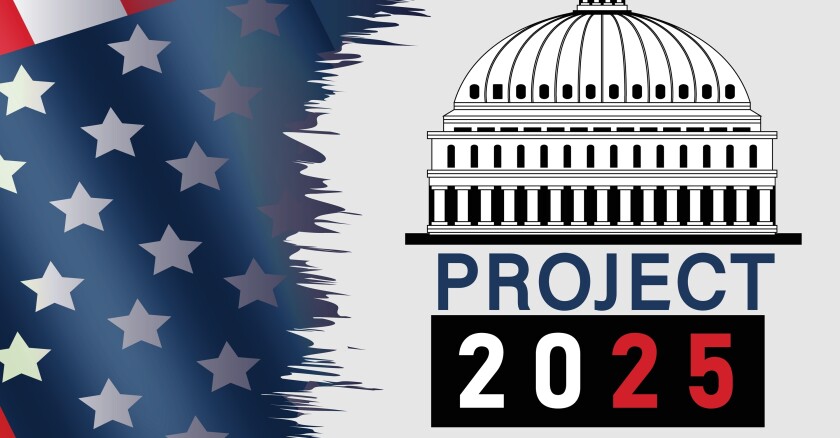
ABOLISHING THE DEPARTMENT OF EDUCATION
- Cutting federal funding for schools that are “pushing critical race theory or gender ideology on our children,” and opening civil rights investigations into them for race-based discrimination.
- Barring trans youth from sports leagues that correlate with their self-identification rather than their assigned sex.
- Creating a body that certifies teachers who “embrace patriotic values.”
- Rewarding districts that do away with teacher tenure.
- Adopting a parents’ bill of rights.
- Having parents directly elect school principals, instead of electing school boards who then hire and supervise principals.
IMPACT ON STUDENT LOANS
Scientific research, can project 2025 happen.

Advertisement
Supported by
Bird Flu Is Spreading. Why Aren’t More People Getting Tested?
Even as the H5N1 virus evolves, gaps remain in the nation’s contingency plans for human testing, scientists say.
- Share full article

By Apoorva Mandavilli
The first step in combating any infectious disease outbreak is detection. Without widespread testing, health officials have little sense of who is infected, when to treat patients and how to monitor their close contacts.
In that sense, the bird flu outbreak plaguing the nation’s dairy farms is spreading virtually unobserved.
As of Monday, the virus had infected 157 herds in 13 states. But while officials have tested thousands of cows and are monitoring hundreds of farmworkers, only about 60 people have been tested for bird flu.
Officials do not have the authority to compel workers to get tested, and there is no way for workers to test themselves. In the current outbreak, just four dairy workers and five poultry workers have tested positive for H5N1, the bird flu virus, but experts believe that many more have been infected.
The Covid-19 pandemic and the mpox (formerly monkeypox) outbreak in 2022 revealed deep fissures in the U.S. approach to testing for emerging pathogens. Those failures prompted federal agencies to move toward policies that would allow rapid scaling of testing during an outbreak.
But progress has been sluggish, interviews with more than a dozen academic and government experts suggest.
We are having trouble retrieving the article content.
Please enable JavaScript in your browser settings.
Thank you for your patience while we verify access. If you are in Reader mode please exit and log into your Times account, or subscribe for all of The Times.
Thank you for your patience while we verify access.
Already a subscriber? Log in .
Want all of The Times? Subscribe .

IMAGES
VIDEO
COMMENTS
To assist the research community to plan for these scenarios we have developed a template that addresses some of the critical aspects of contingency planning. It is expected that research teams that utilize specialized equipment, chemicals, human subjects, animal models complete a template.
Contingency planning is important in research because often times, technology, people and experiments in general can be unpredictable and fixing a mistake or an issue often takes more time if there is no contingency plan in place. ... Research Proposals. Scientific communication SyBBURE Searle December 13, 2019. Setting Research Goals. Project ...
A contingency plan example may be positive like when there's an unexpected surplus in the cash flow. But more often than not, the contingency planning process mostly refers to negative events. The events which might have a bearing on the organization's financial health, reputation or on its ability to continue with business operations.
The research proposal should include, whenever possible, a contingency plan in case some parts of the project go wrong or cannot be carried out. 25 Planning an alternative approach - a plan B - is particularly relevant when most of the objectives are interrelated and (unexpected) negative results from one may compromise the opportunity of ...
A business contingency plan is an action plan that is used to respond to future events that might or might not affect a company in the future. In most cases, a contingency plan is devised to respond to a negative event that can tarnish a company's reputation or even its business continuity. However, there are positive contingency plans, such ...
Contingency planning is what your project team does to prepare for specific risks that might happen during a project. A contingency plan might include extra funds, extra staff, or steps to take if a particular issue arises. Contingency planning is "surviving disruptions," says Erika Andresen, a business continuity and resilience expert ...
The Office of Research & Innovation (ORI) encourages researchers to develop individual contingency plans for possible disruptive scenarios that may affect your research activities. Three potential overarching scenarios are: potential reduction in a research team's workforce due to sickness or the inability to perform planned research activities;
Simple Contingency Plan Template. Use this simple contingency plan template to help your organization return to daily operations after unforeseen circumstances. Find sections for business impact analysis (BIA), recovery strategies, plan development, and testing and exercises. By completing these areas, you can stress-test your contingency plan.
A contingency plan is executed when the risk presents itself. The purpose of the plan is to lessen the damage of the risk when it occurs. Without the plan in place, the full impact of the risk could greatly affect the project. The contingency plan is the last line of defense against the risk.
To ensure safety of our researchers, staff, and research participants and to be aligned with the most recent NIH guidance, the Office of Research & Innovation is requesting that research involving person-to-person contact or gatherings of human research participants be paused as soon as possible unless needed for participant safety.
Lastly, they work with a reputable PR firm to prepare a plan for outreach and messaging to reassure customers in the event that their personal information is compromised. The value of contingency planning . When business operations are disrupted by a negative event, good contingency planning gives an organization's response structure and ...
Identify who needs to be aware of and involved in contingency planning. Choose appropriate communication methods for each stakeholder group. For instance, department heads may need specific meetings to focus on their section of the plan. Key employees might need a training session.
5 steps to create and manage an effective contingency plan. 1. Assess the identified risks for high impact. Review the risk register you have created, and select the risks that need to be included in a contingency plan. You can do this by assessing risks based on likelihood, impact, and severity.
A contingency plan is a proactive strategy to address risks and ensure project continuity when unforeseen events occur. Contingency planning helps manage risks, minimize impacts, and keep projects on track. A robust contingency plan can enhance resilience, protect project objectives, and improve project success rates.
contingency plans have emerged to re medy from post -disaster situations. T he ultimate goal in the. event of a disaster is to avail of the appropriate resources to ensure quick restoration to ...
A contingency plan is a practical plan you must put in place if a foreseeable risk materialises. It serves as a "Plan B" for when things don't turn out as predicted. A business contingency plan can reduce risk and help you return to normal operations. Contingency plans help in responding to natural disasters.
Here is a practical definition for contingency planning: The process of planning for response to an event or emergency; managing the escalation of an emergency into a crisis condition; recovery and resumption of activities from an emergency or crisis for the infrastructure, and executing critical processes, and other elements of a business or ...
The contingency plan for that is to provide training (at a cost of $5,000) to ensure technical alignment and higher efficiency. If the team does need training, the risk becomes an issue, and the contingency plan swings into action to provide that training at a cost of $5,000. Project schedules can also make use of contingency plans.
A project contingency plan is an established, pragmatic set of actions that your team will follow if a predetermined risk materializes and makes your initial plan impossible. For example, your software development team is updating a website for a retail company. In the middle of the project, your lead full-stack developer accepts a position ...
According to the United Nations Office for Disaster Risk Reduction ( UNDRR ), a contingency plan is a management process that analyzes specific potential events or emerging situations that might threaten society. These plans establish arrangements in advance to enable timely, effective, and appropriate responses to such events and situations.
One of the benefits of planning in advance is that you have time to brainstorm responses. If the disruption has happened before, ask them what they did to resolve it and what they wish they had done differently. 3. Determine who needs to know. Once you've created a viable plan, determine who the stakeholders are.
The plan recommends deep cuts or elimination of federal monies for research and investment in renewable energy and calls to "stop the war on oil and natural gas."
Proposal Due Date: May 16, 2024, by 5:00 PM local time of applicant ... o Appropriateness of the Budget and Research Plan . ROA Section 4: Post-award expectations ... o Milestone-driven projects with contingency plans o Special award terms o Flexibility to alter the course of the project (e.g., expanded, modified,
Climate Change: The proposal would undo much of the federal government's climate work, including by leaving the Paris Climate Agreement, overhauling the Department of Energy to promote oil and ...
revisions of the Agency's LongTerm Renewable Resources Procurement Plan, conducting key research, - modeling, and analysis related to assessing resource adequacy and reliability for Illinois, providing research and analysis to support the Agency's understanding of the economics of clean energy development, and other tasks as needed.
Even as the H5N1 virus evolves, gaps remain in the nation's contingency plans for human testing, scientists say. By Apoorva Mandavilli The first step in combating any infectious disease outbreak ...